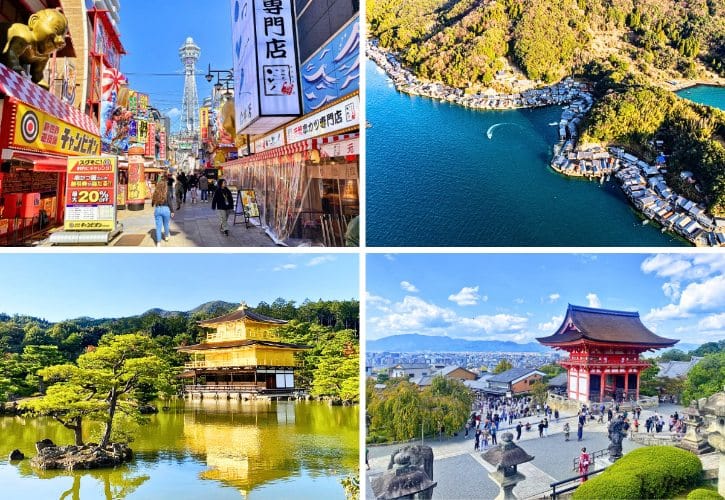
Planning your trip to Osaka, Nara, and Kyoto, but not sure where to start?
This easy-to-follow 7-day itinerary shows you where to stay, the best places to visit, tasty foods to enjoy, and helpful tips for getting around.
It also gives you step-by-step instructions for smoothly traveling from one location to the next.
I hope this guide saves you research time, so you can relax and fully enjoy your trip! 😊
Day 1: Namba, Shinsekai, Dotonbori and Shinsaibashi Shopping Street
10:00 AM: Getting from Kansai International Airport to Namba
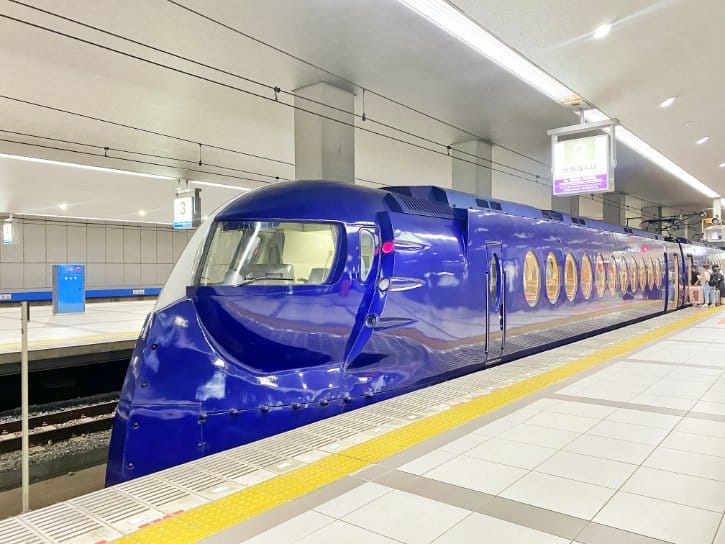
- To get to Namba Station in Osaka, take the Nankai Rapi:t (Nankai Limited Express) from Kansai Airport Station.
- The train station is on the second floor of Terminal 1 at Kansai Airport.
- This express train travels directly to Namba Station without transfers.
- The journey takes about 38 minutes, and the fare is ¥1,490.
- The first and last trains depart at 6:53 AM and 11:00 PM on weekdays, and 7:06 AM and 10:55 PM on weekends.
Note: The Nankai Limited Express train has convenient storage areas for your luggage.
Money-Saving Tip: Why pay the full fare? Book your tickets online here to receive an additional discount compared to purchasing at Kansai train station!
11:00 AM: Hotel Check-in Near Namba Station (Osaka)
a. Recommended Hotels

- Hiyori Hotel Osaka Namba Station (Booking.com | Agoda): If you’re looking for a hotel right in front of Nankai Namba Station, this is a great choice. The hotel provides quick and easy access to Kansai Airport in just 38 minutes by Nankai Rapid Express. It’s also convenient for traveling directly to Nara using the Kintetsu-Nara Line from Osaka-Namba Station.
- Sotetsu Fresa Inn Osaka-Namba (Booking.com | Agoda): Conveniently situated in front of Exit 7 of Namba Metro Station, this hotel also has a FamilyMart convenience store right next door.
- APA Hotel & Resort Osaka Namba Ekimae Tower (Booking.com | Agoda): Affordable accommodation just a 1-minute walk from JR Namba Station, with a 7-Eleven convenience store nearby.
- Hotel IL Cuore Namba (Booking.com | Agoda): Located near Namba Metro Station and only about a 3-minute walk from Nankai Namba Station, with a FamilyMart convenience store nearby.
- MIMARU Osaka Namba Station (Booking.com | Agoda): Ideal for families and groups, MIMARU Osaka Namba Station provides spacious apartment-style accommodations with fully equipped kitchens.
b. Why Stay in Namba?
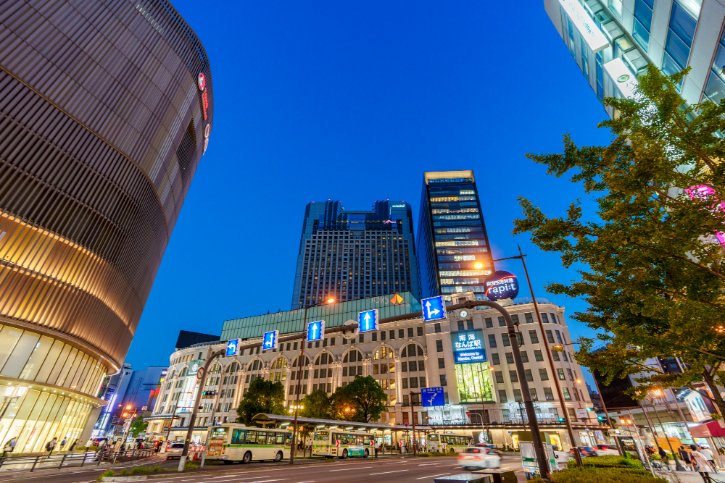
- Easy Access to Kansai Airport: From Kansai International Airport, you can reach Namba directly with a 38-minute ride on the Nankai Limited Express train.
- Close to Dotonbori: Enjoy easy access to Dotonbori’s famous nightlife district, just a 7-minute walk away.
- Multiple Train Lines: Several train lines pass through Namba Station, making it simple to explore Osaka’s popular attractions.
- Convenient Day Trip to Nara: You can easily take a direct Kintetsu Nara Line Rapid Express train from Osaka-Namba Station to Kintetsu Nara Station for an easy day trip.
- Short Ride to Umeda Station: From Namba Station, take a direct 12-minute metro ride to Umeda Station, where you can easily transfer to a train bound for Kyoto.
- Easy Access to Shin-Osaka Station: Namba Station offers a direct 18-minute metro ride to Shin-Osaka Station, where you can catch the Shinkansen to Tokyo and other regions across Japan.
Read More: Only 3 Best Places to Stay in Osaka
12:00 PM: Lunch in the Shinsekai Area
a. Kura Sushi Shinsekai Tsutenkaku Branch
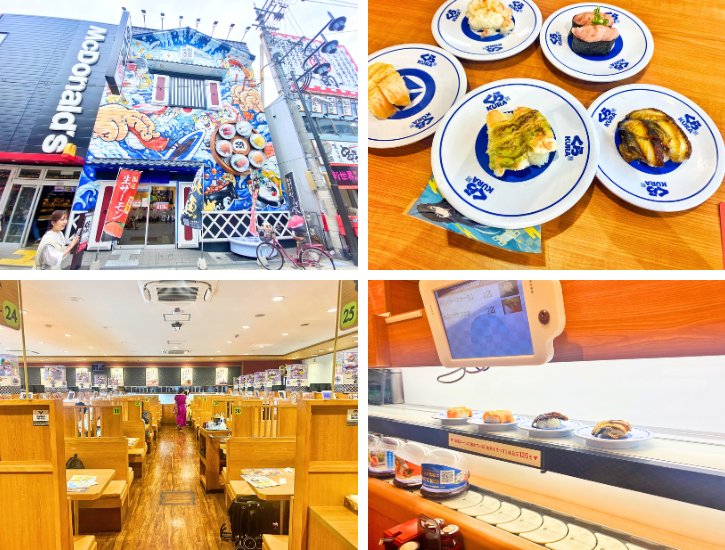
- What They Sell: A conveyor belt sushi restaurant serving fresh sushi, noodles, fried snacks, and desserts. Great for all ages.
- Must-Try Dishes: Grilled Shrimp with Basil Cheese, Grilled Eel, Fresh Tuna Sushi, Salmon Sushi, and Shrimp Sushi.
- Budget: Affordable, around ¥1,000–¥1,500 per person.
b. Kushikatsu Daruma
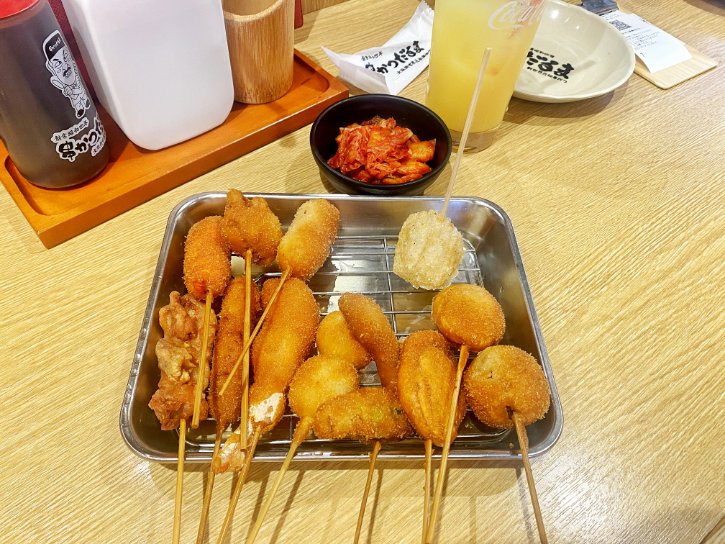
- What They Sell: Deep-fried skewers (kushikatsu) in the Osaka style. Choices include meat, seafood, vegetables, and more.
- Must-Try Dishes:
- New World Set: A popular assortment including pork, shrimp, sausage, cheese chikuwa (fish cake filled with cheese), vegetables, and Doteyaki (beef tendon stew).
- Dotonbori Set: Another tasty option with pork, shrimp, sausage, cheese chikuwa, and Doteyaki stew.
- Recommended Individual Skewers: Beef (original), pork, shrimp, asparagus, and cheese chikuwa.
- Dining Tip: Dip each skewer into the shared sauce only once. If you want more sauce, scoop it using the provided cabbage.
- Budget: Around ¥1,700–¥2,800 per person.
How to Get to the Restaurants Listed Above from the Recommended Hotels
- Option 1: Take the JR Yamatoji Line from JR Namba Station to Shin-Imamiya Station for ¥150 in 4 minutes. Use the Tsutenkaku Exit (East Exit), then walk 7 minutes to the restaurants listed above.
- Option 2: Take the Osaka Metro Midosuji Line from Namba Station to Dobutsuen-mae Station for ¥190 in 5 minutes. Use Exit 5, then walk 7 minutes to the restaurants listed above.
1:00 PM: Shinsekai
a. Overview
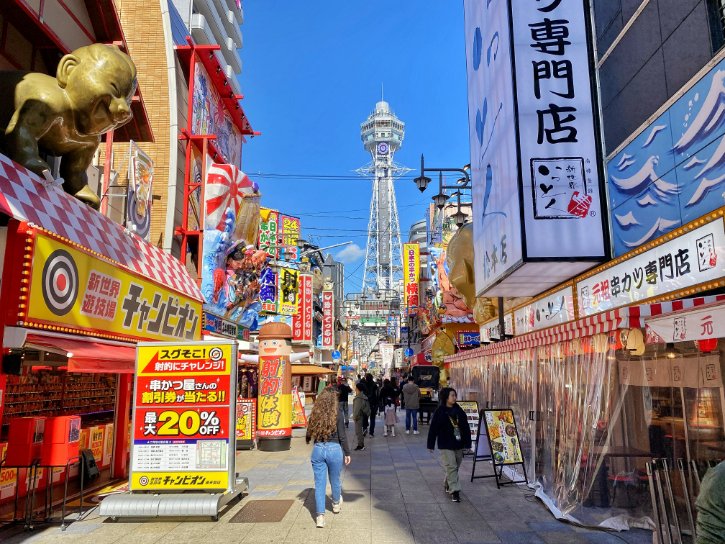
- What It Is: Shinsekai (“New World”) is a colorful neighborhood in Osaka known for the famous Tsutenkaku Tower, lively streets, and delicious local restaurants.
- History: Shinsekai was built in 1912, inspired by New York and Paris. It declined after World War II but is now a lively, popular area again.
- Why Visit: You can experience both old and new Osaka here. Try local favorites like kushikatsu (deep-fried skewers), explore retro arcades, and get amazing views from Tsutenkaku Tower.
- Atmosphere: You’ll feel nostalgic exploring streets lit by neon lights, vintage signs, and busy restaurants that show the real Osaka culture.
b. Top Things to See and Do
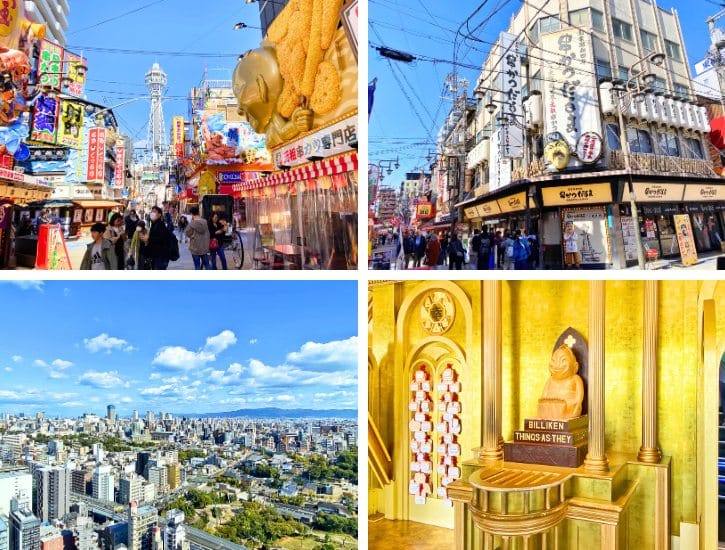
- Take Fun Photos: Take quirky photos with Shinsekai’s famous icons, including giant signs, colorful lanterns, and the Billiken statue. They’re great for selfies or group pictures.
- Enjoy Local Food: Try delicious local dishes like kushikatsu (deep-fried skewers), takoyaki (octopus balls), and doteyaki (braised beef tendon stew).
- Visit Tsutenkaku Tower: This famous 103-meter tower offers fantastic city views. Be sure to rub the feet of the Billiken statue for good luck.
- Explore Janjan Yokocho: Walk along this lively, narrow street packed with small restaurants and bars. It’s a great place to eat, drink, and experience local life.
- Shop at Shinsekai Market: Browse the covered market area for affordable souvenirs, traditional sweets, and interesting local items.
c. How to Get to Shinsekai from the Recommended Restaurants Above
Shinsekai is located in the same area as the recommended restaurants.
3:30 PM: Namba Yasaka Jinja
a. Overview
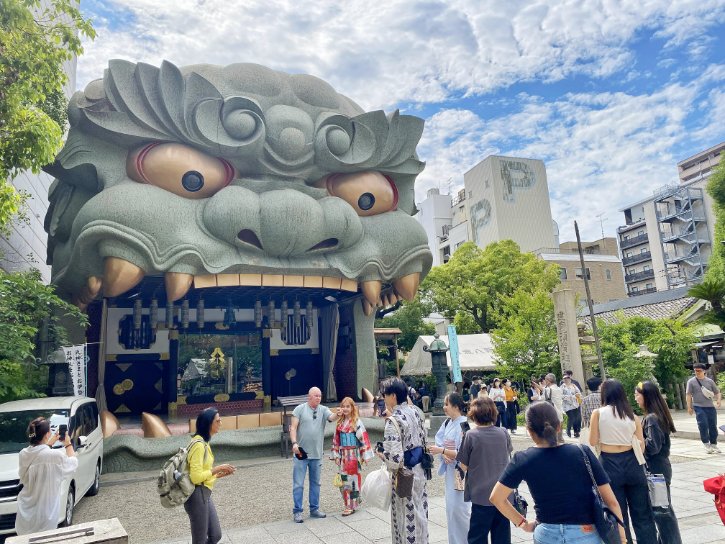
- What It Is: A Shinto shrine in Osaka famous for its giant lion head, 12 meters tall, that protects visitors by swallowing bad spirits.
- History: This shrine is over 950 years old, first built around 1069. It was destroyed in World War II and rebuilt in 1974.
- Why Visit: You’ll enjoy its unique architecture and peaceful atmosphere. It’s also popular if you’re seeking good luck in studies or business.
- Atmosphere: Calm, relaxing, and especially beautiful during cherry blossom season.
b. Must-Do Experiences Around the Shrine
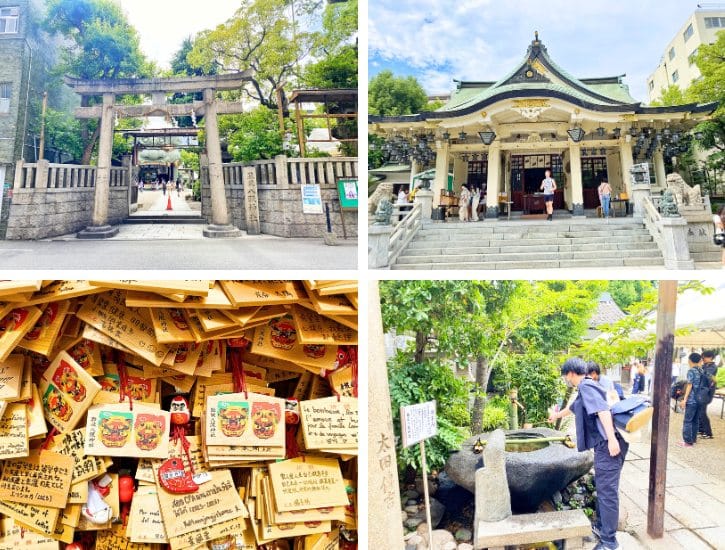
- Best Photo Spot: Take a memorable photo standing in front of the giant lion head. There’s plenty of open space, making it easy to capture the whole structure.
- Main Hall (Honden): Visit the main hall to offer a small donation, bow, clap your hands, and quietly make a prayer or wish.
- Ema Plaques: Write your wishes on wooden plaques called ema, and hang them at the shrine. It’s an enjoyable and meaningful activity.
- Omikuji Fortunes: Draw a fortune slip (omikuji) to check your luck. If you get a bad fortune, tie it up in the designated spot to leave any bad luck behind.
- Charm and Amulet Shop: Browse the shrine’s shop for charms (omamori) that bring luck, good health, or success. They also make thoughtful souvenirs.
Read More: A Complete Guide to Namba Yasaka Shrine
c. How to Get to Namba Yasaka Jinja from Shinsekai
Take the Osaka Metro Midosuji Line from Dobutsuen-Mae Station to Daikokucho Station for ¥190 in 2 minutes. Use Exit 2 and walk 7 minutes to Namba Yasaka Jinja.
4:30 PM: Hozenji Yokocho
a. Overview
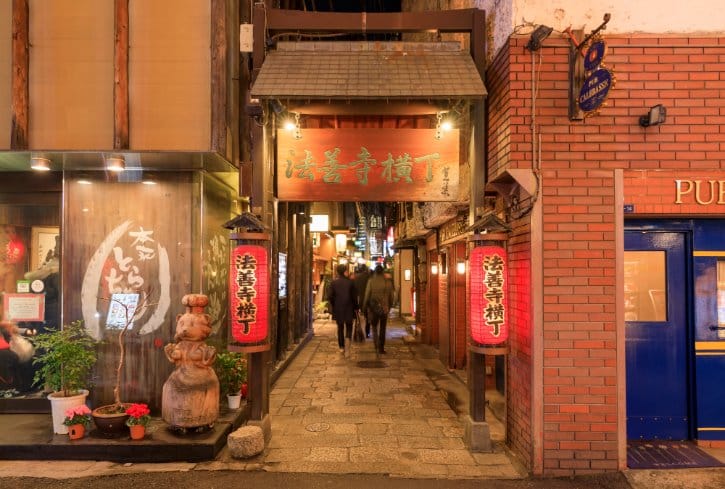
- What It Is: Hozenji Yokocho is a short, stone-paved alley near Dotonbori in Osaka. It’s famous for traditional restaurants, shops, and the historic Hozenji Temple.
- History: It started in the Edo Period as a place for visitors to Hozenji Temple. After being destroyed in World War II, local people rebuilt it, keeping its historical feel.
- Why Visit: You’ll experience the charm of old Osaka and taste delicious local foods. You can also visit the temple’s unique moss-covered statue and enjoy a peaceful break from the busy city.
- Atmosphere: Quiet and calm during the day, but lively and romantic at night with lanterns lighting up the narrow street.
b. Top Experiences You Shouldn’t Miss
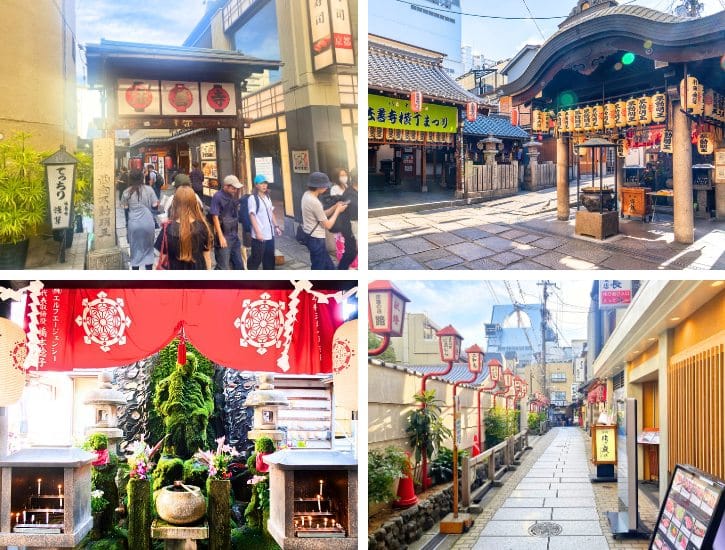
- Hozenji Temple
- Main Attraction: Visit the famous “Mizukake Fudo”, a Buddha statue covered in moss. People splash water on it for good luck.
- What to Do: Gently pour water on the statue using the ladles provided, and quietly make a wish or prayer for good luck.
- Tiny Bars and Cafes to Try
- Arabia Coffee: A cozy, vintage cafe serving excellent coffee and tasty French toast, perfect for an afternoon rest.
- Robatayaki Mizukake Chaya: A welcoming bar where you can enjoy charcoal-grilled dishes like scallops and vegetables prepared right in front of you.
- Stroll the Alley: A leisurely 10-minute walk through the alley lets you admire traditional lanterns and charming old buildings.
c. Best Foods to Try
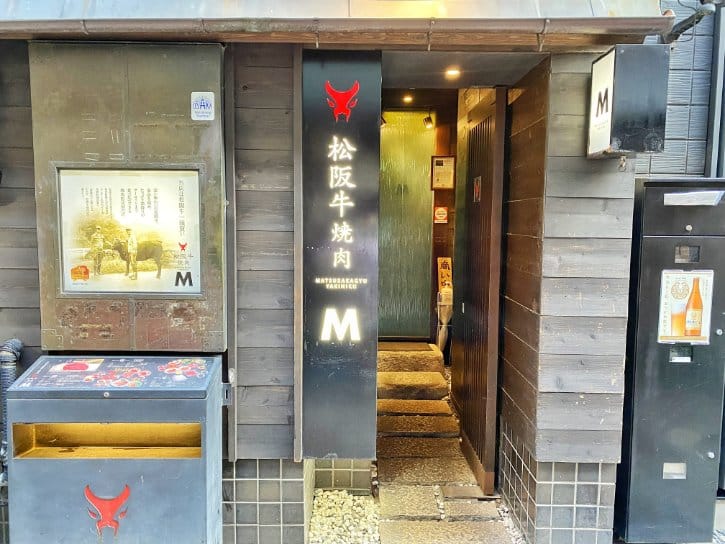
- Matsusaka Beef (Premium Wagyu Beef): Matsusakagyu Yakiniku M offers top-quality grilled beef cooked right at your table. Reservations are recommended.
- Okonomiyaki (Savory Pancakes): Try authentic local versions at Hozenji Sanpei or Yakizen, both popular spots.
- Kushikatsu (Fried Skewers): At Kushikatsu Daruma, enjoy skewers of pork, shrimp, and vegetables with a cold beer. Remember, only dip your skewer into the sauce once!
- Katsudon (Pork Cutlet Bowl): Katsudon Hozenji Yokocho serves tasty pork cutlets cooked with eggs and onions on top of rice.
- Meoto Zenzai (Sweet Red Bean Soup): This famous dessert from the Meoto Zenzai shop comes in two bowls, symbolizing harmony for couples, but it’s delicious even if you’re on your own.
d. How to Get to Hozenji Yokocho from Namba Yasaka Jinja
It’s a 16-minute walk from Namba Yasaka Jinja to Hozenji Yokocho.
5:00 PM: Dotonbori
a. Overview
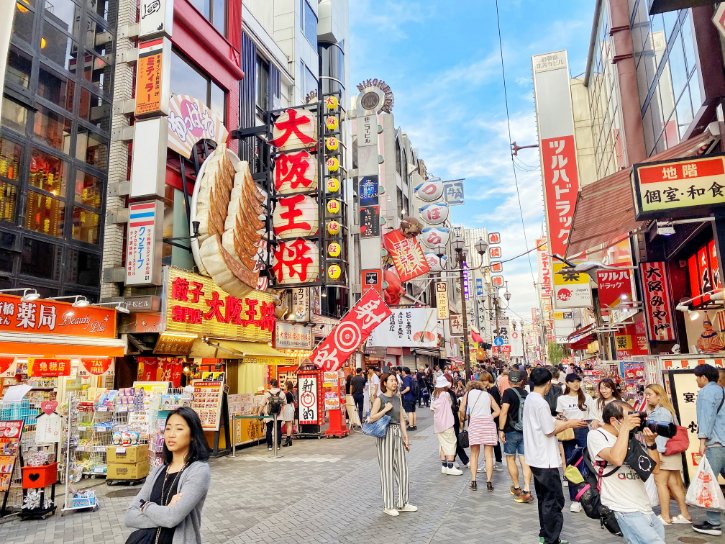
- What It Is: Dotonbori is a lively neighborhood along a canal in Osaka. It’s known for delicious food, bright neon signs, shopping, and nightlife.
- History: It started over 400 years ago as an area famous for theaters and entertainment. Today, it’s Osaka’s top spot for food and nightlife.
- Why Visit: You can taste Osaka’s most popular foods, enjoy its vibrant atmosphere, and see iconic sights like the Glico Running Man billboard.
- Atmosphere: Busy, fun, and full of life, especially at night. Crowds gather around neon lights and street food stalls, giving it a festive feel.
b. Must Try Foods
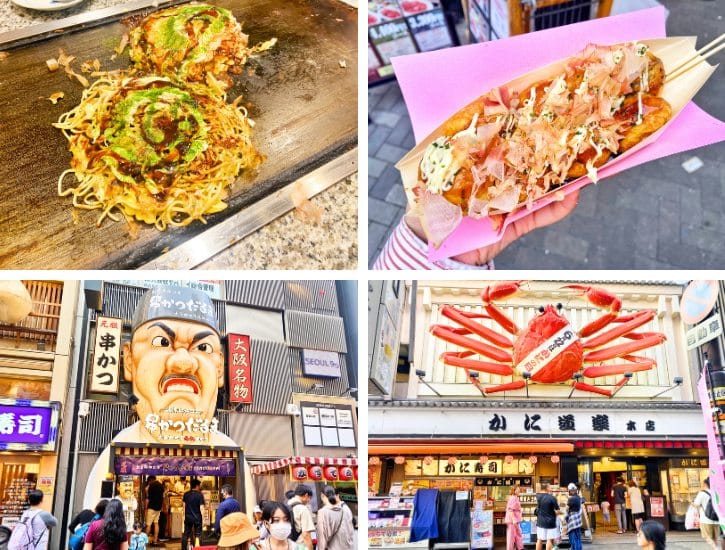
- Okonomiyaki (Mizuno): A tasty, savory pancake with toppings like pork or seafood, cooked fresh on a hot grill.
- Takoyaki (Takoyaki Wanaka): Small round snacks filled with octopus, topped with sauce and bonito flakes. Try them freshly made from street stalls.
- Kushikatsu (Kushikatsu Daruma): Crispy deep-fried skewers of meat or vegetables. A popular place to try is Kushikatsu Daruma. Remember to dip each skewer only once in the shared sauce.
- Ramen (Kinryu Ramen | Dotombori Kamukura Sennichimae): Visit Kinryu Ramen for flavorful pork broth (open 24 hours) or Dotombori Kamukura Sennichimae for delicious ramen with a clear broth.
- Seafood and Crab (Kani Doraku): A famous crab restaurant with a huge moving crab sign. It’s a bit expensive, but nearby street stalls sell tasty crab snacks at cheaper prices.
c. Top Sightseeing Spots
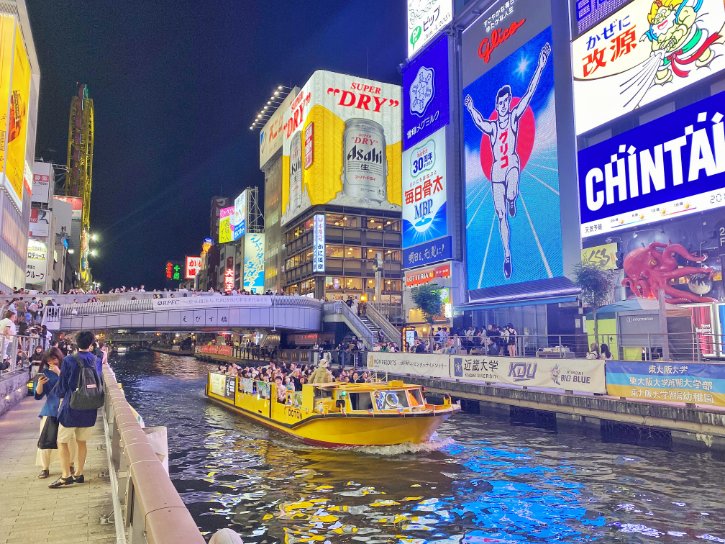
- Glico Running Man Sign: The famous neon sign above Ebisubashi Bridge, perfect for taking selfies.
- Giant Signboards: Look for big, eye-catching signs like the giant moving crab at Kani Doraku or the dragon at Kinryu Ramen. Great spots for photos.
- Ebisubashi Bridge & Dotonbori Canal: A popular pedestrian bridge offering fantastic views of neon-lit billboards and the canal. It’s ideal for both daytime and nighttime photos.
- Don Quijote Ferris Wheel (Ebisu Tower): A unique oval-shaped Ferris wheel attached to the Don Quijote store. You’ll get great views over Dotonbori in just about 15 minutes.
- River Cruises: Short boat tours along the canal. These are especially beautiful at night and great for photos. Rides last about 20 minutes.
d. How to Get to Dotonbori Street from Hozenji Yokocho
It’s a 2-minute walk from Hozenji Yokocho to Dotonbori Street.
6:30 PM: Dinner in the Dotonbori
a. Dotonbori Kamukura Sennichimae
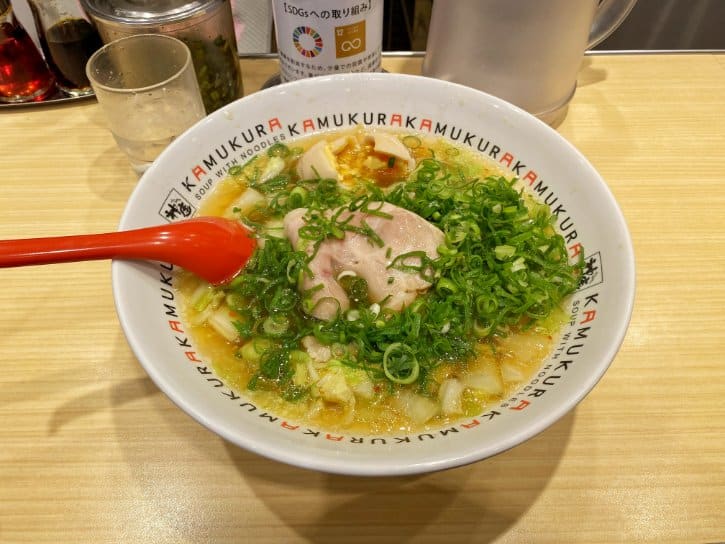
- What They Sell: A ramen restaurant known for tasty ramen with a soy sauce-based broth. It’s famous for its rich but mild flavor.
- Must-Try Dishes:
- Oishii Ramen (Delicious Ramen): Their special ramen with pork and Chinese cabbage.
- Gyoza (Dumplings): Crispy fried dumplings, a popular side dish.
- Budget:
- Ramen dishes range from ¥820 to ¥1,270.
- Side dishes like gyoza cost about ¥280.
b. Daiki-suisan Kaitenzushi
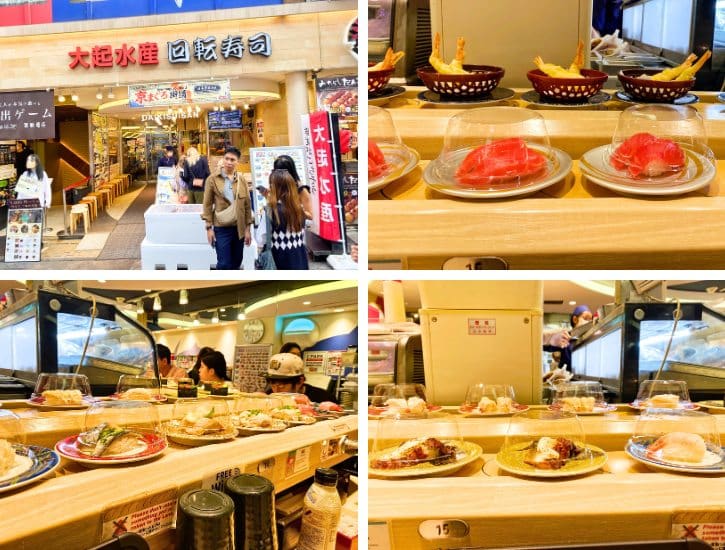
- What They Sell: Conveyor-belt sushi restaurant offering fresh sushi at affordable prices.
- Must-Try Dishes: Fresh salmon, scallops, sea urchin (uni), and sweet shrimp.
- Budget: Plates cost from ¥100 to ¥700 each. Expect to spend about ¥1,500–¥3,000 per person, depending on what you order.
7:30 PM: Shinsaibashi-Suji Shopping Street
a. Overview
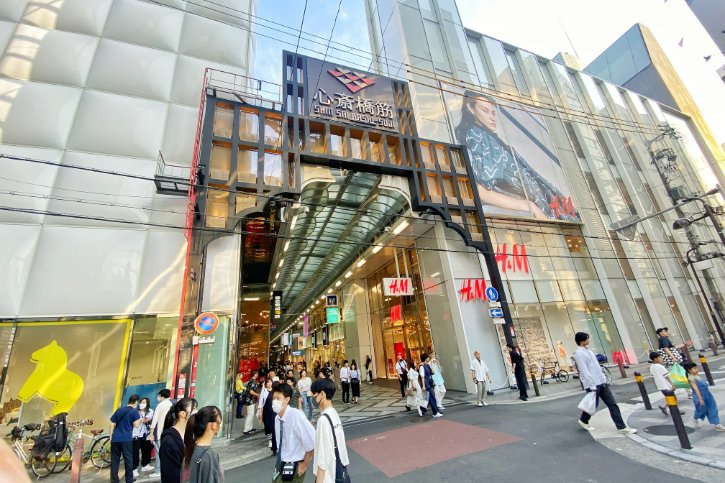
- What It Is: Shinsaibashi is a covered shopping street in Osaka filled with fashion shops, cosmetics stores, restaurants, and cafes.
- History: It started 400 years ago near Shinsaibashi Bridge and has grown into Osaka’s busiest and most famous shopping area.
- Why Visit: You can explore over 180 stores, discover local fashion trends, shop for Japanese cosmetics, and enjoy tasty street snacks, all in one convenient place.
- Atmosphere: Bright, lively, and busy with shoppers. The covered arcade makes shopping comfortable in any weather.
b. Fashion and Cosmetics
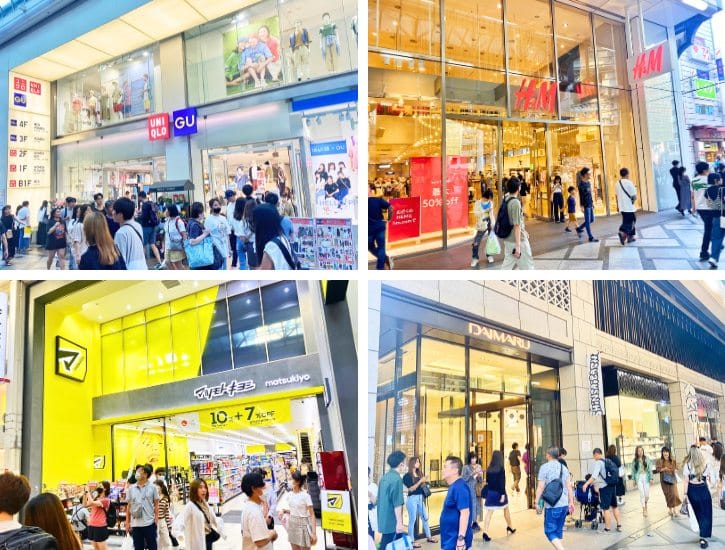
- UNIQLO: Quality casual clothing at good prices.
- GU: Trendy, affordable Japanese fashion brand, ideal for budget shopping.
- H&M, ZARA: International stores offering stylish clothes at reasonable prices.
- Daimaru Shinsaibashi: Famous department store selling luxury brands, offering great service, and tax-free shopping.
- Midosuji Street: Next to Shinsaibashi arcade, lined with luxury shops like Chanel, Louis Vuitton, Dior, and Cartier.
- Matsumoto Kiyoshi and Daikoku Drug: Popular Japanese drugstores selling affordable beauty products, skincare, makeup, health items, and snacks. Often have discounts and tax-free shopping.
c. How to Get to Shinsaibashi-Suji Shopping Street from Dotonbori
It’s a 2-minute walk from Dotonbori Street to Shinsaibashi-Suji Shopping Street.
Day 2: Sumiyoshi Taisha, Kuromon Ichiba Market, Osaka Castle and Umeda Sky Building
10:00 AM: Sumiyoshi Taisha
a. Overview
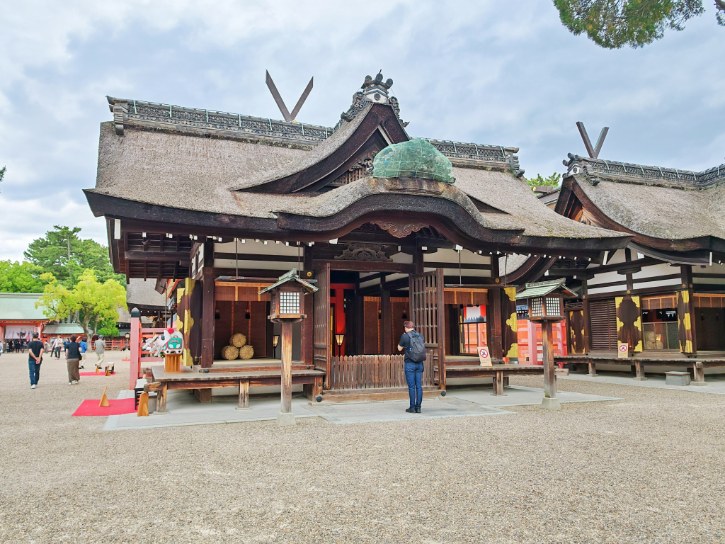
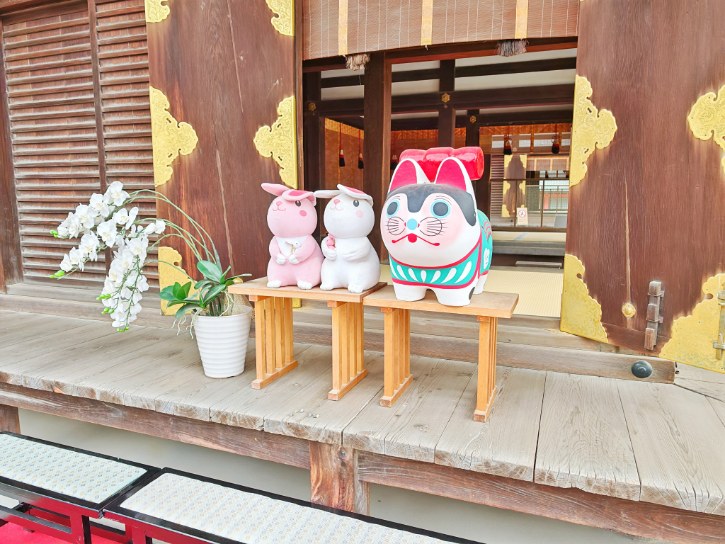
- What It Is: Sumiyoshi Taisha is a famous Shinto shrine in Osaka. It’s the main shrine of over 2,300 Sumiyoshi shrines across Japan.
- History: The shrine was built about 2,000 years ago by Empress Jingū. It’s dedicated to sea gods who protect sailors and merchants, highlighting Osaka’s history as a port city.
- Why Visit: You can see the shrine’s unique buildings (Sumiyoshi-zukuri), the beautiful red arched bridge (Sorihashi), and peaceful gardens. It’s also a great place to pray for health, family happiness, and good luck.
- Atmosphere: Calm, peaceful, and spiritual. Usually quiet, but lively and crowded during special events, especially around the New Year.
b. Cross the Iconic Sorihashi Bridge
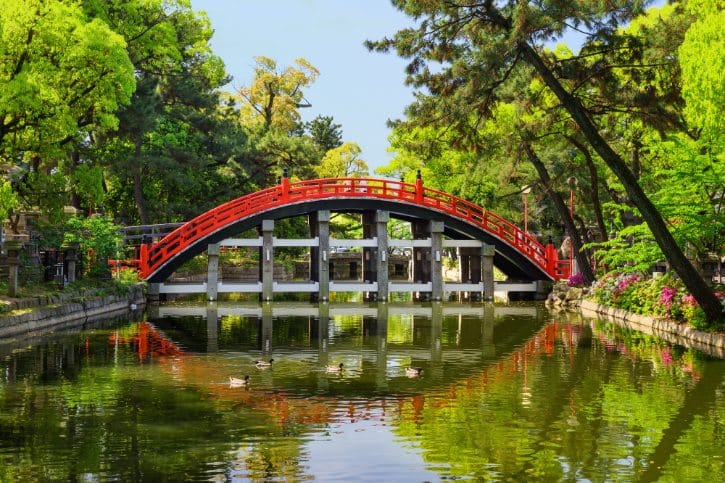
Walk across the famous red arched bridge at the shrine’s entrance. It’s believed to remove bad luck and is a wonderful spot to take photos.
c. Discover the Shrine’s Main Treasures
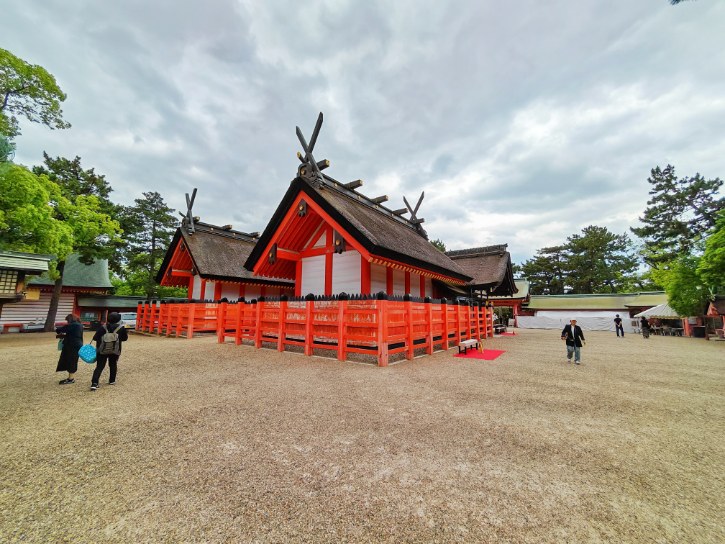
Visit the four main shrine buildings, recognized as National Treasures. Each shrine honors a different deity. To pray, bow twice, clap your hands twice, then bow once more.
d. Find Special Blessings at Smaller Shrines
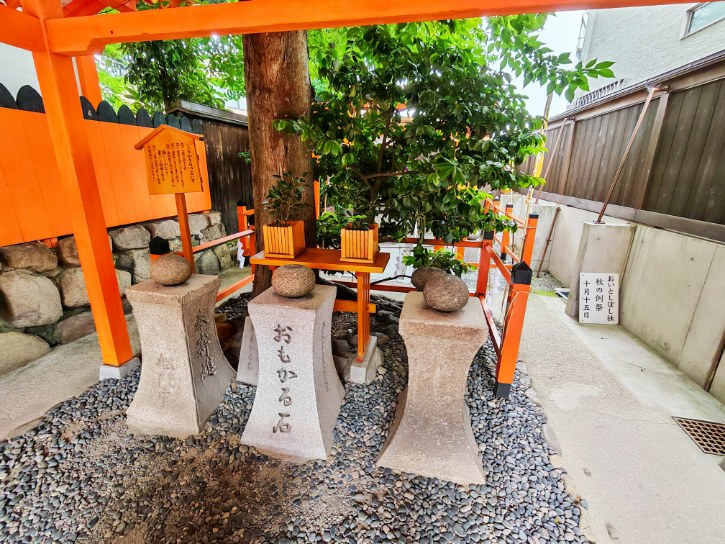
- Omokaru Ishi: After making a wish, lift the special stone called “Omokaru Ishi”. If it feels lighter than you expect, your wish may come true.
- Tanekashi-sha: Popular with couples wishing for fertility or hoping to have children.
- Nankun-sha: Visit this shrine if you want good luck in business and wealth.
- 1,000-Year-Old Camphor Tree: Near the Nankun-sha shrine, see a huge sacred camphor tree that’s over 1,000 years old. It’s peaceful and perfect for photos.
e. Explore the Lucky Goshogozen Sacred Stones
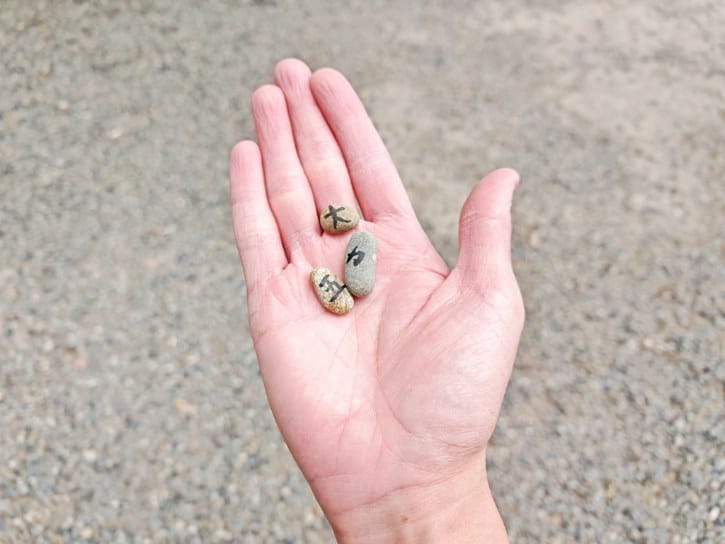
This special area is near the main shrines. Look for small stones marked with 五 (five), 大 (great), and 力 (power). Finding these stones is believed to bring you luck, strength, wisdom, happiness, and success.
f. How to Get to Sumiyoshi Taisha from Namba
Take the Nankai Main Line from Namba Station (Nankai Line) to Sumiyoshi Taisha Station for ¥240 in 9 minutes. Use the East Exit, then walk about 2 minutes to Sumiyoshi Taisha Shrine.
12:30 PM: Kuromon Ichiba Market + Lunch
a. Overview
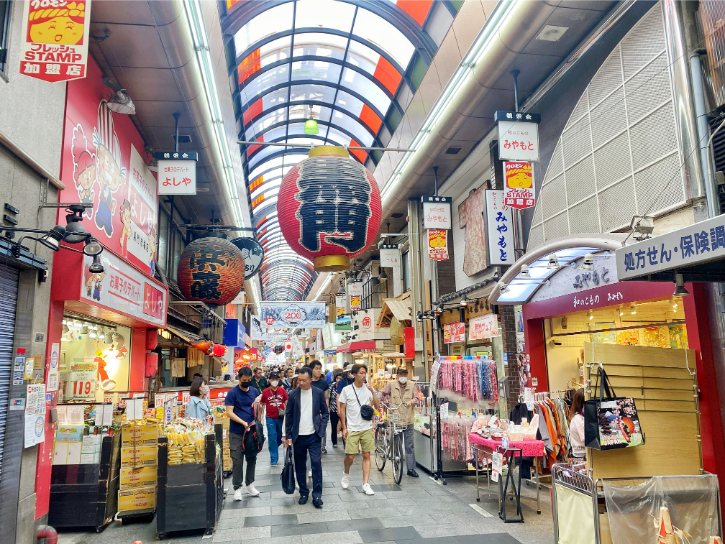
- What It Is: Kuromon Ichiba is a lively covered market about 600 meters long, with over 150 shops and food stalls.
- History: Established in 1902, it’s known locally as “Osaka’s Kitchen” because it’s famous for fresh food and everyday goods.
- Why Visit: You can enjoy Osaka’s delicious street foods, shop for fresh ingredients, and get a real taste of local life.
- Atmosphere: The market is busy, full of friendly vendors, and smells amazing from all the tasty foods being cooked.
b. Delicious Foods You Shouldn’t Miss

- Fresh Seafood: Taste fresh raw tuna, salmon sashimi, grilled scallops, oysters, or king crab legs. Prices range from ¥500 to over ¥2,500 depending on size and type.
- Wagyu Beef Skewers: Juicy, tender grilled beef skewers (like Kobe or Matsusaka beef). Prices usually ¥1,000 to ¥2,500 per skewer, based on quality.
- Takoyaki (Octopus Balls): Crispy on the outside and soft on the inside, topped with sauce and mayo. Around ¥500 to ¥600 for 6 to 8 pieces.
- Oden (Hotpot Snacks): Simple, comforting foods like radish, egg, tofu, and fishcakes cooked in broth. Each item costs about ¥100 to ¥200.
- Sweets & Snacks: Try strawberry daifuku (sweet rice cakes filled with red bean paste and strawberries), taiyaki (crispy fish-shaped pancakes), or dorayaki (sweet pancake sandwiches). Prices around ¥200 to ¥300 each.
- Fresh Fruits & Juices: Seasonal fresh fruits like strawberries or melon slices on sticks, or enjoy fresh fruit juices. Prices from ¥300 to ¥800 depending on fruit type.
c. Having Lunch at Niboshi-Ramen Tamagoro in Kuromon Market
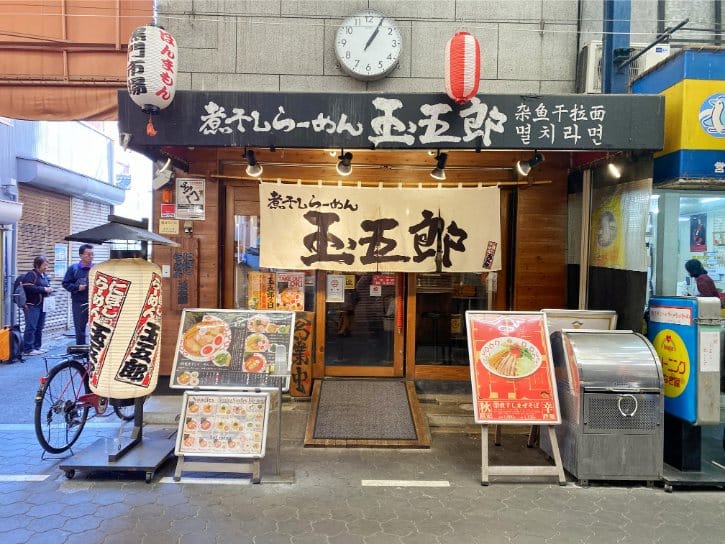
- What They Sell: Niboshi ramen, which is Japanese noodles served in broth made from dried sardines and pork bones. They also have dipping noodles (tsukemen).
- Must-Try Dishes:
- Niboshi Ramen (Dried Small Sardines Noodles): Classic ramen with dried sardines and pork broth, topped with tender pork slices and bamboo shoots.
- Special Niboshi Ramen (Specially Made Noodles): Same broth as classic, but comes with extra pork slices, bamboo shoots, and a seasoned soft-boiled egg.
- Tsukemen: Cold noodles served separately with rich dipping broth.
- Budget:
- Regular ramen costs about ¥950 to ¥1250.
- Adding extras or ordering combo meals usually costs less than ¥1,500 per person.
d. How to Get to Kuromon Ichiba Market from Sumiyoshi Taisha
Take the Hankai Tramway Hankaidenki-Hankai Line from Sumiyoshi Station to Shin-Imamiya-Ekimae Station. Then, walk to Dobutsuen-mae Station and take the Osaka Metro Sakaisuji Line to Nippombashi Station (¥430 in 17 minutes total). At Nippombashi Station, use Exit 9 and walk about 3 minutes to Kuromon Ichiba Market.
3:00 PM: Osaka Castle
a. Overview
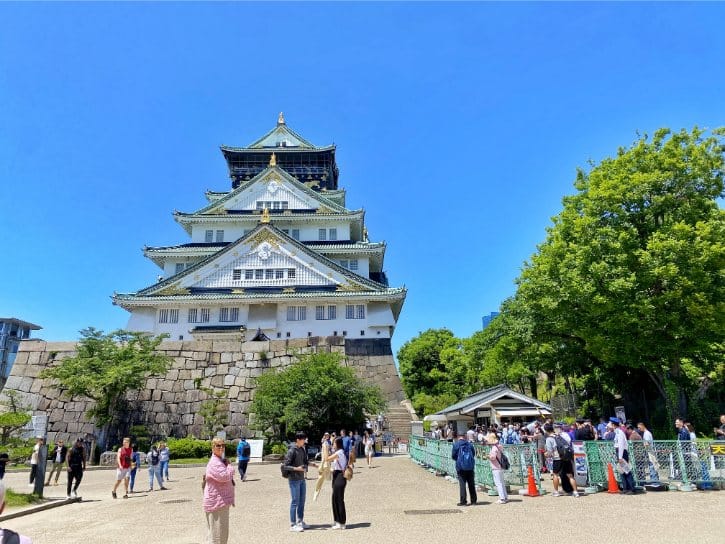
- What It Is: Osaka Castle is a famous landmark known for its impressive architecture, history, and great city views.
- History: Built in 1586 by Toyotomi Hideyoshi as a symbol of power. It was involved in many battles, including the Siege of Osaka, and was rebuilt several times. The current main tower was reconstructed in concrete in 1931.
- Why Visit: You can experience Japan’s past by viewing historical displays and artifacts inside the castle. The park around the castle is great for picnics, especially during cherry blossom season.
- Atmosphere: Relax in peaceful gardens surrounded by moats. It’s a calm escape from busy city life with lovely views and greenery.
b. Inside the Castle
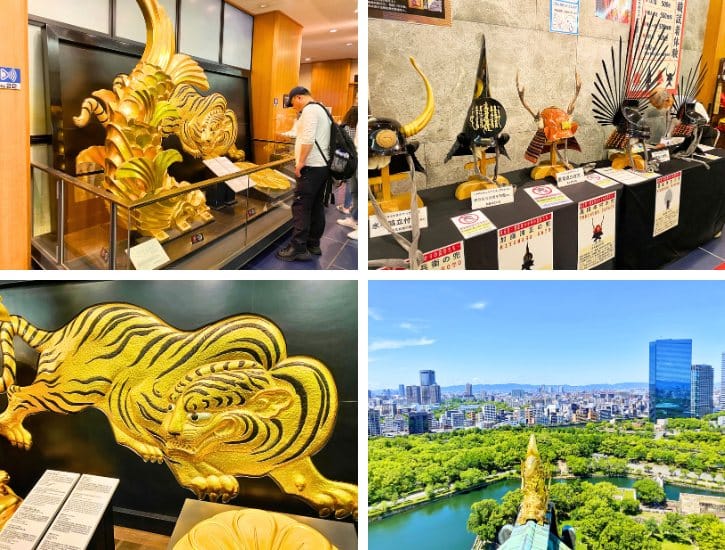
- 1st Floor (Introduction Film): Watch a short video introducing the castle’s history.
- 2nd Floor (Castle Construction): Learn how the castle was built and see models of the golden roof decorations.
- 3rd Floor (Golden Tea Room): View a replica of Toyotomi Hideyoshi’s luxurious golden tea room.
- 4th Floor (Samurai Exhibits): See samurai armor, weapons, and learn about their battle strategies.
- 5th Floor (Battle Paintings): Check out paintings showing dramatic scenes from the Summer War of Osaka.
- 6th Floor (Closed Corridor): This floor is not open to visitors.
- 7th Floor (Miniature Displays): Look at miniature scenes of important moments in Toyotomi’s life.
- 8th Floor (Observation Deck): Enjoy fantastic 360-degree views of Osaka from the top floor.
c. Relax and Enjoy Osaka Castle Park
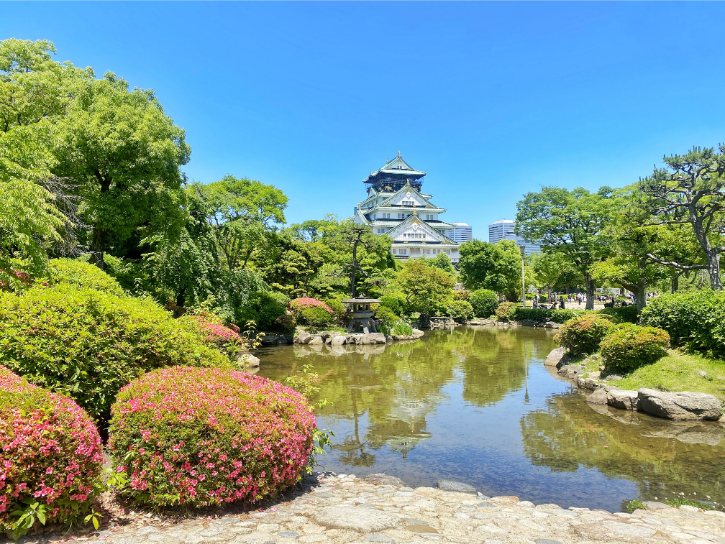
- Seasonal Scenery: The castle’s park is spacious and beautiful, especially during cherry blossom season (late March to early April) and autumn (November).
- Nishinomaru Garden: Enjoy relaxing in this quiet garden, famous for cherry blossoms in spring. Entry costs ¥200, but the beautiful views of the castle surrounded by blossoms are worth it.
- Moats and Stone Walls: Take an easy walk along the castle’s huge stone walls and moats. You’ll be amazed at their size and careful craftsmanship.
d. How to Get to Osaka Castle from Kuromon Ichiba Market
Take the Osaka Metro Sennichimae Line from Nippombashi Station to Tanimachi 9-chome Station. Transfer to the Osaka Metro Tanimachi Line and ride to Tanimachi 4-chome Station (¥190 in 12 minutes total). From Tanimachi 4-chome Station, use Exit 1-B and walk about 20 minutes to Osaka Castle.
5:30 PM: Umeda Sky Building (Kuchu Teien Observatory)
a. Overview

- What It Is: Umeda Sky Building is a 173-meter skyscraper in Osaka. It has two 40-story towers connected by the Kuchu Teien Observatory (“Floating Garden”) with amazing views of the city.
- History: Designed by Hiroshi Hara in 1993 as part of a city renewal project. It was originally planned to have four towers. In 2008, it was named one of the world’s top 20 buildings.
- Why Visit: You can enjoy incredible city views from the rooftop Sky Walk, especially beautiful at sunset. Ride the famous glass escalators between the towers, and leave your own padlock at the rooftop Heart Lock area.
- Atmosphere: Feel the contrast between the modern architecture of the building and the nostalgic atmosphere of the nearby Takimi Koji area. It’s a great spot to watch Osaka change from day to night.
b. Kuchu Teien Observatory Highlights

- Arrival Floor (35F): High-speed elevators take you quickly up to the 35th floor, where you transfer to the famous glass escalators.
- Glass Escalators (35F–39F): Unique glass-covered escalators connecting the two towers. You’ll get exciting city views as you ride upward.
- Indoor Observatory (39F): Main indoor observation area with large windows offering great panoramic views. There’s also a gift shop, information center, and access to cafés and restaurants.
- Sky 40 Café (40F): Relaxing café offering drinks, snacks, and international beers. Enjoy comfortable seating by large windows with impressive views of the city below.
- Open-air Rooftop (Sky Walk): The rooftop observatory (“Floating Garden”) offers breathtaking 360-degree views at 173 meters high. It’s perfect for photos and enjoying fresh air.
- Nighttime Experience (Lumi Sky Walk): At night, the rooftop lights up with glowing patterns, creating a special and memorable atmosphere.
Extra Tip:
Takimi Koji (B1F): Visit this underground area designed like a retro street. You can enjoy traditional restaurants serving delicious local Osaka food.
c. How to Get to Umeda Sky Building (Kuchu Teien Observatory) from Osaka Castle
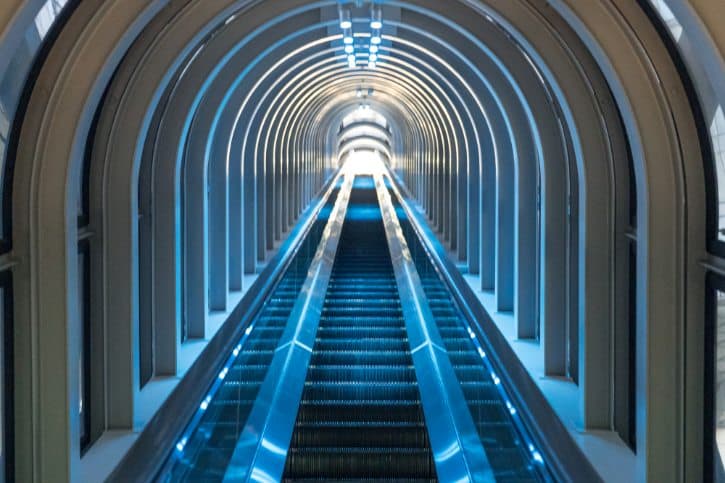
- Take the Osaka Loop Line from Osakajokoen Station to Osaka Station for ¥180 in 30 minutes. Exit via the West Exit and walk about 12 minutes to Umeda Sky Building.
- Enter the Umeda Sky Building through Fun Fun Plaza.
- Take the escalator up to the 3rd floor to access the observatory.
- From the 3rd floor, ride the elevator to the 35th floor.
- Ride the glass-enclosed escalator from the 35th floor to the 39th floor (this escalator is a popular photo spot, offering panoramic views through its glass windows).
- Upon reaching the 39th floor, explore the indoor observatory area. For an open-air experience, proceed to the rooftop to enjoy stunning 360-degree panoramic views of Osaka.
7:30 PM: Dinner near Osaka Station
a. Hakodate Gourmet Kaitenzushi Kantaro Grand Front Osaka
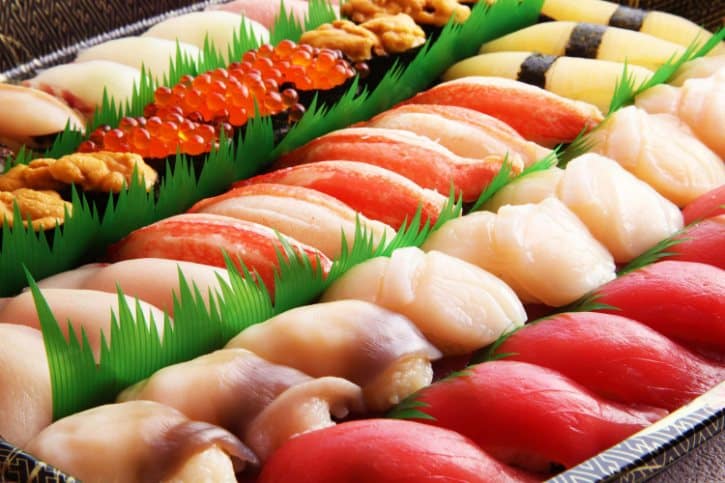
- What They Sell: Conveyor-belt sushi with fresh seafood delivered from Hokkaido.
- Must-Try Dishes: Fatty tuna (otoro), scallops (hotate), salmon roe sushi (ikura), and seared fluke fin (engawa).
- Budget: Around ¥3,000 to ¥4,000 per person.
b. Menya Takei Hankyu Umeda
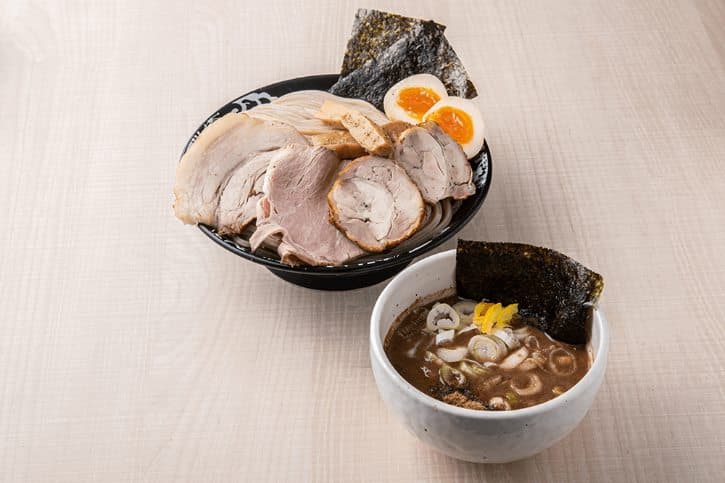
- What They Sell: Delicious ramen and dipping noodles (tsukemen) with a flavorful pork and seafood broth.
- Must-Try Dishes: Special tsukemen, which has thick noodles, rich dipping broth, and tasty toppings like pork, chicken, and egg. Also try the spicy pork rice bowl as a side dish.
- Budget: Regular ramen or tsukemen costs about ¥980 to ¥1,110. Special dishes cost around ¥1,240 or more. Expect to spend about ¥1,000 to ¥1,600 per person.
c. Ichiran Umeda
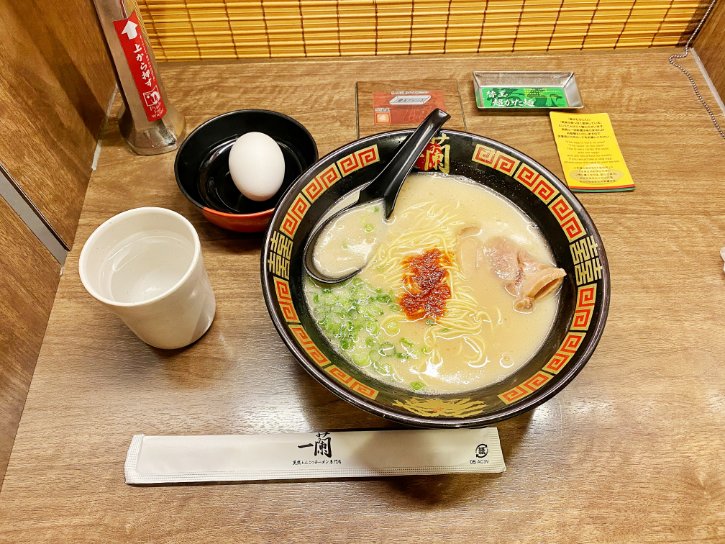
- What They Sell: Specializes in ramen with rich pork-bone broth (tonkotsu ramen).
- Must-Try Dishes: Classic Ichiran tonkotsu ramen served with thin noodles, their special spicy red sauce, and slices of pork. If you’re still hungry, order a noodle refill (“kaedama”).
- Budget: Basic ramen costs ¥1,080. Extra toppings range from ¥130 to ¥260 each, and a noodle refill is ¥210. You’ll likely spend around ¥1,000 to ¥1,500 per person.
How to Get to the Restaurants Above from Umeda Sky Building
It’s just a 10 to 12 minute walk from Umeda Sky Building to Hakodate Gourmet Kaitenzushi Kantaro Grand Front Osaka, Menya Takei Hankyu Umeda, and Ichiran Umeda.
Day 3: Nara Day Trip from Osaka
a. Overview
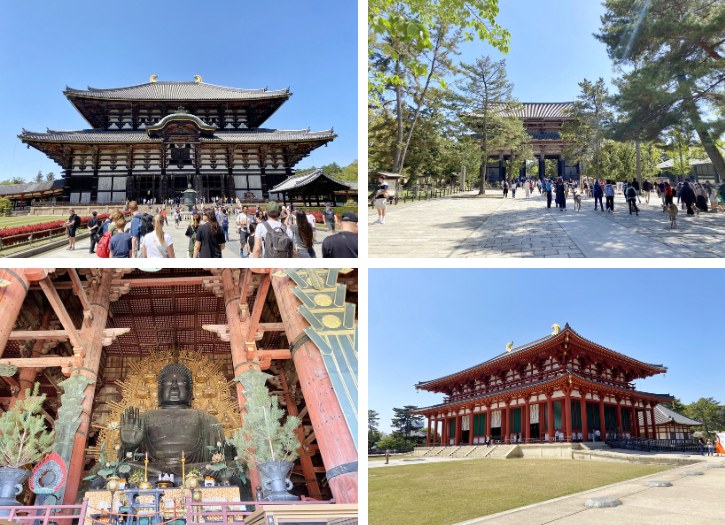
- What It Is: A historic city near Kyoto and Osaka, famous for temples, parks, and deer.
- History: Was Japan’s first capital during the Nara period (710–784 AD), known for early Buddhism.
- Why Visit: Famous for ancient temples, friendly deer, peaceful parks, and UNESCO World Heritage sites.
- Atmosphere: Calm, friendly, easy-going; quieter than big cities, great for relaxed exploring on foot.
b. Must-Visit Spots
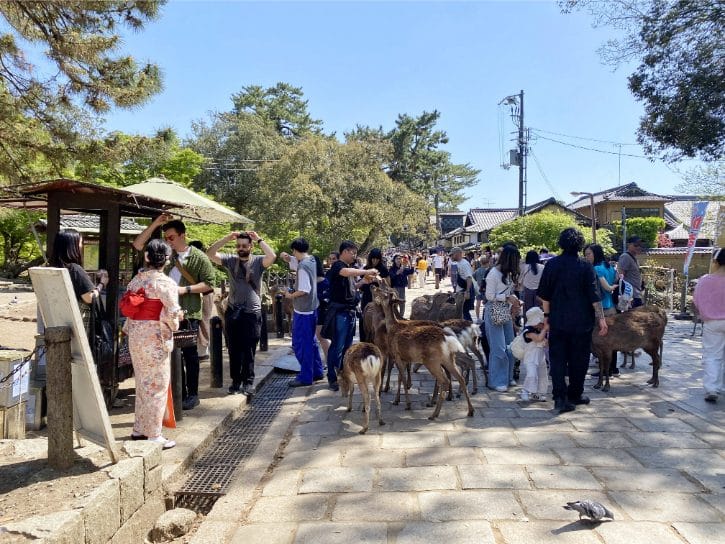
- Kohfukuji Temple: A historic temple famous for its beautiful five-story pagoda and ancient Buddhist sculptures. Currently, the pagoda is under restoration but still worth a visit.
- Nara Deer Park: A large park known for friendly wild deer that roam freely and bow to visitors when given special deer crackers.
- Todaiji Temple: A world-famous temple housing the impressive Giant Buddha statue inside one of the world’s largest wooden buildings.
- Nakatanidou Mochi Shop: A popular mochi shop known for its entertaining live mochi-pounding performances and delicious fresh mochi snacks.
Read More: The Complete Guide to a Day Trip to Nara from Osaka or Kyoto
Option 1 – Day 4: Universal Studios Japan
a. Overview
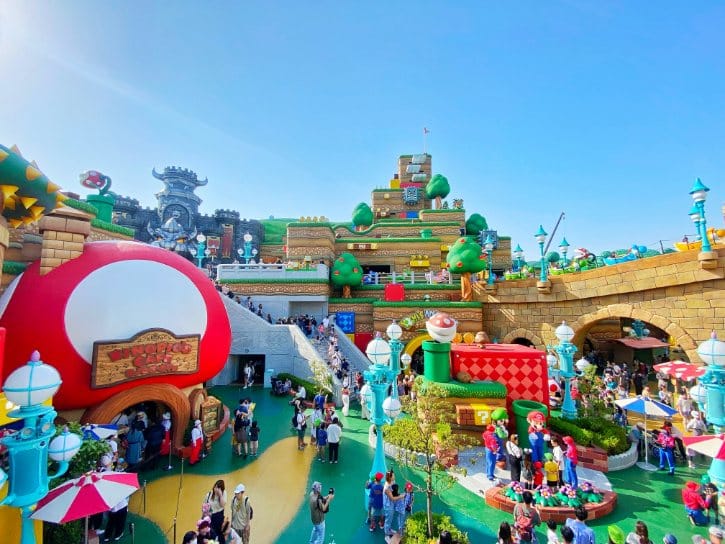
- What It Is: Universal Studios Japan is a popular theme park in Osaka with rides and attractions based on movies, games, and Japanese pop culture.
- History: It opened in 2001 and has expanded to include Harry Potter (2014), Minion Park (2017), Super Nintendo World (2021), and Donkey Kong Country (December 2024).
- Why Visit: You can enjoy unique experiences at Super Nintendo World, exciting Harry Potter attractions, thrilling rides, and areas designed for families.
- Atmosphere: The park is lively and fun, with immersive areas like Jurassic Park, Harry Potter’s village, and Mario’s Mushroom Kingdom.
b. Thrilling Rides You Can’t Miss
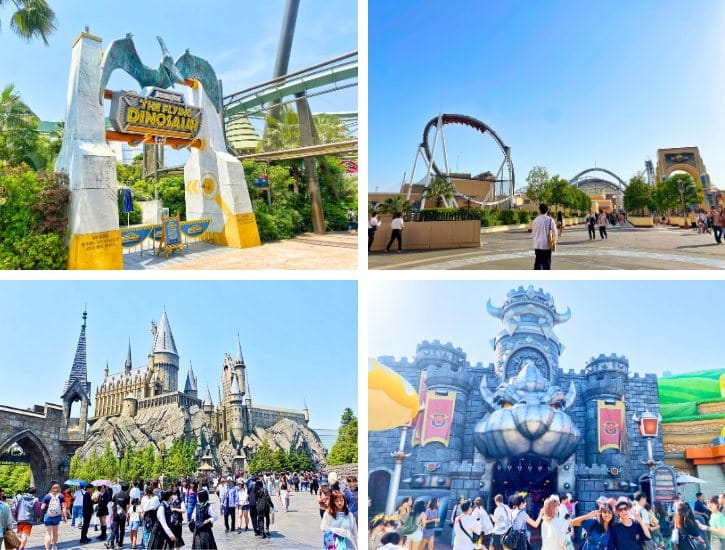
- The Flying Dinosaur: An intense roller coaster in Jurassic Park where you ride face-down, going through loops at high speeds.
- Hollywood Dream – The Ride (Backdrop): A fast roller coaster offering a backward ride called “Backdrop” for extra excitement.
- Jurassic Park: The Ride: A boat ride that ends with a thrilling drop into a big splash of water.
- Harry Potter and the Forbidden Journey: A thrilling simulator ride through the Harry Potter world. It doesn’t have big drops but includes exciting movements.
- Mario Kart: Koopa’s Challenge: A fun, interactive racing ride in Super Nintendo World using AR technology, moderately thrilling.
c. Family-Friendly Fun for Everyone
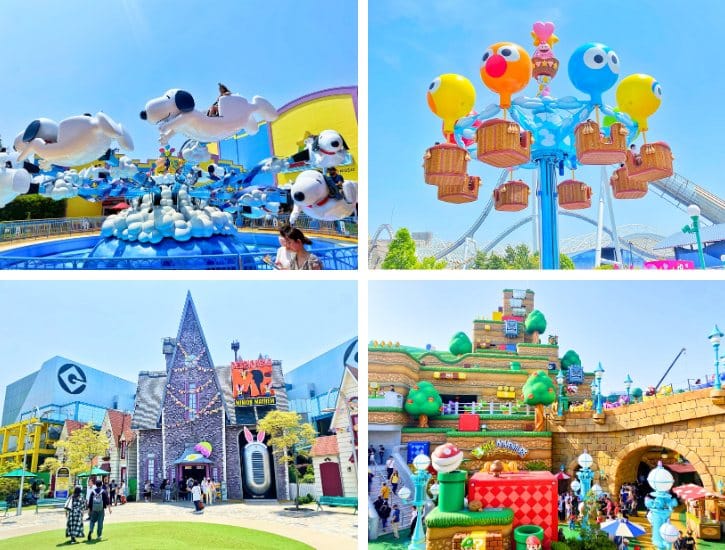
- Universal Wonderland: Fun, gentle rides and play areas featuring Snoopy, Hello Kitty, and Sesame Street characters. Ideal for younger kids.
- Despicable Me Minion Mayhem: A family-friendly simulator ride enjoyable for all Minion fans.
- Super Nintendo World & Donkey Kong Country: Enjoy gentle family-friendly rides like Yoshi’s Adventure and the new Mine Cart Madness, which is moderately thrilling.
- Flight of the Hippogriff: A mild roller coaster in the Harry Potter area that’s suitable for younger children.
d. Tips for Visitors (including Donkey Kong Country Access)
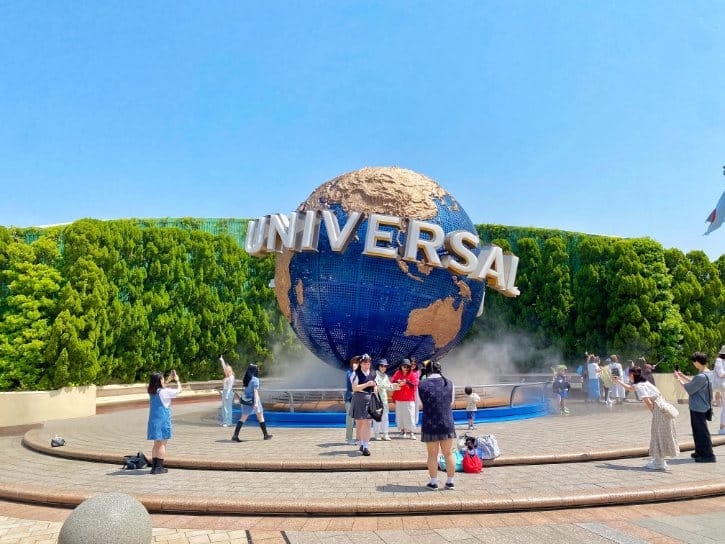
- Buy Tickets Online: Save time and avoid long entry lines by purchasing your tickets online in advance.
- Visit Early & on Weekdays: Go early on weekdays, especially Wednesday or Thursday, to avoid large crowds.
- Timed-Entry to Super Nintendo World & Donkey Kong Country:
- Reserve your free timed-entry tickets using the official USJ app as soon as you enter the park.
- Donkey Kong Country is included within Super Nintendo World, so you don’t need a separate reservation.
- Express Pass Advantage:
- Consider buying an Express Pass online before your visit to skip long lines at popular attractions.
- Some Express Passes guarantee timed entry to Super Nintendo World (including Donkey Kong Country), so you won’t need a separate reservation.
- Express Passes sell out quickly, so buy yours early.
- Single Rider Lines: Use the single rider lines for shorter waits on popular rides like Flying Dinosaur, Mario Kart, Hollywood Dream, and Harry Potter and the Forbidden Journey, if you’re okay riding separately.
- Have a Plan: Arrive early and visit your top-choice rides first, as Mario Kart, Flying Dinosaur, and Harry Potter attractions are usually the busiest.
e. Recommended Restaurants
1. Kinopio’s Café (Super Nintendo World)
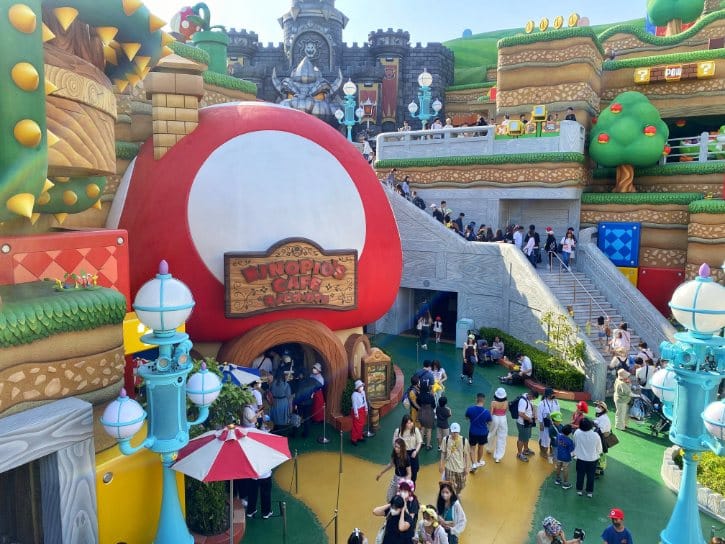
- What They Sell: Mario-themed burgers, pizzas, and desserts.
- Must-Try Dishes: Mario’s Bacon Cheeseburger, Princess Peach’s Cake (good to share).
- Budget: About ¥2,000 to ¥3,000 per person.
2. Three Broomsticks (Wizarding World of Harry Potter)
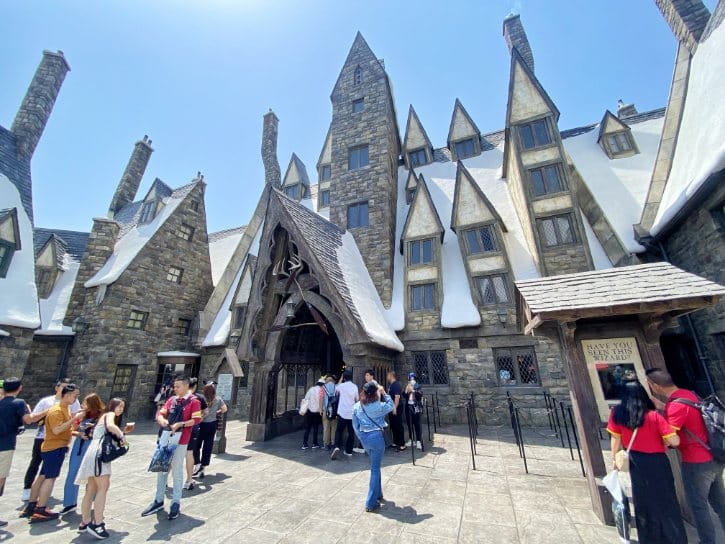
- What They Sell: British-style pub food like fish & chips and shepherd’s pie.
- Must-Try Dishes: Fish & Chips, Shepherd’s Pie, Butterbeer.
- Budget: About ¥2,000 to ¥3,500 per person.
3. Happiness Cafe (Minion Park)
- What They Sell: Minion-themed burgers, curry omelette rice, and snacks.
- Must-Try Dishes: Minion Curry Omurice, Minion Burger Set (includes unlimited drink refills).
- Budget: About ¥1,800 to ¥2,200 per person.
4. Mel’s Drive-In (Hollywood Area)
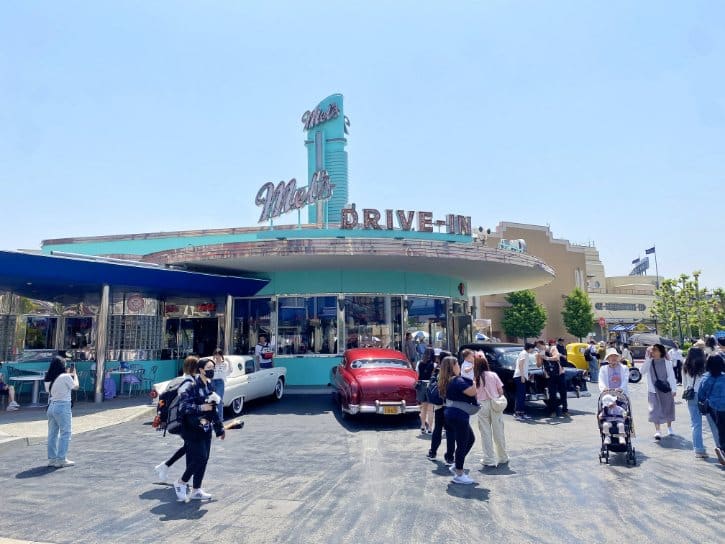
- What They Sell: Classic American burgers, fries, hot dogs, and milkshakes.
- Must-Try Dishes: BBQ Bacon Cheeseburger, Classic Cheeseburger.
- Budget: About ¥1,700 to ¥2,000 per person.
Read More: 3 Best Ways to Get to Universal Studios Japan
Option 2 – Day 4: Exploring Amanohashidate and Ine Funaya
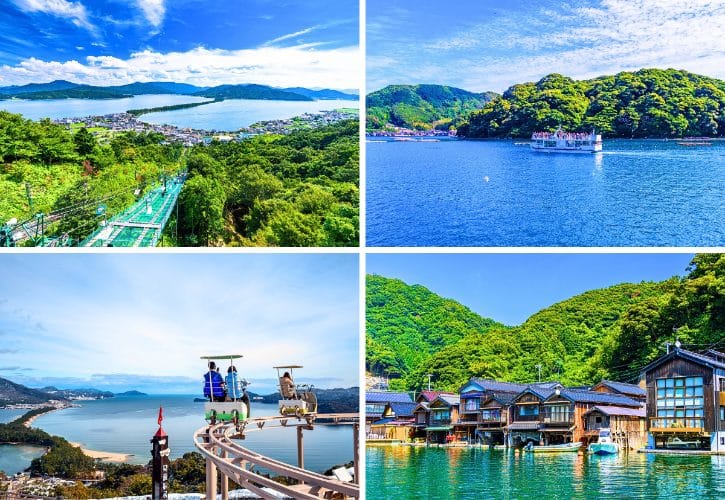
If you plan to visit Amanohashidate and Ine Funaya instead of Universal Studios Japan, I recommend doing this trip while staying in Kyoto.
These two places offer stunning coastal scenery and a peaceful atmosphere. It’s a great escape from the crowds and gives you a very different experience from the city.
Departing from Kyoto Station is more convenient and closer than from Osaka.
The easiest way to visit Amanohashidate and Ine Funaya is by joining a popular bus tour (Bus Tour 1 or Bus Tour 2), with pick-up available from either Osaka or Kyoto, depending on your chosen tour.
If you prefer traveling independently, you can read my complete guide to Amanohashidate and Ine Funaya here. I’ve covered all the details on how to get there.
After returning from these places, you can have your dinner at the restaurant below.
Dinner near or at Kyoto Station
a. Kyoto Ramen Koji
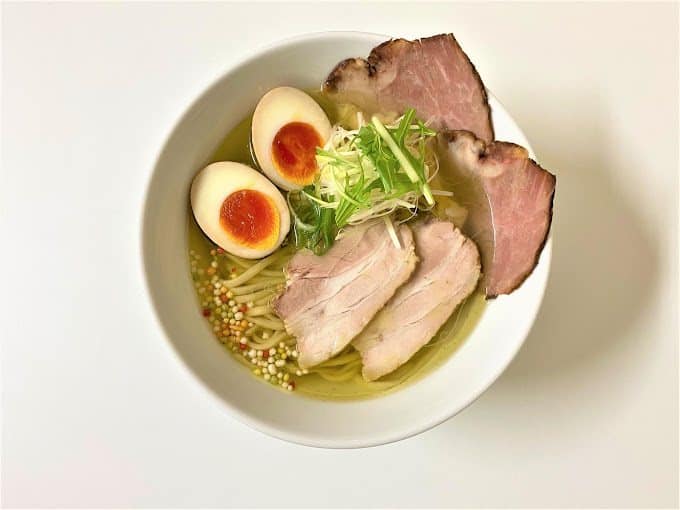
- What They Sell: A ramen area on the 10th floor of Kyoto Station where you can enjoy ramen from 8 different regions in one place.
- Must-Try Dishes:
- Gion Miyako Ramen: Rich chicken broth ramen served with fresh vegetable toppings.
- Chicken Salt Ramen: Clear, tasty chicken broth seasoned with salt, topped with tender slices of chicken. A good choice if you prefer lighter ramen.
- Budget: Affordable, around ¥700 to ¥1,200 per bowl.
b. Daiki Suisan Kaitenzushi Kyoto Tower Sand
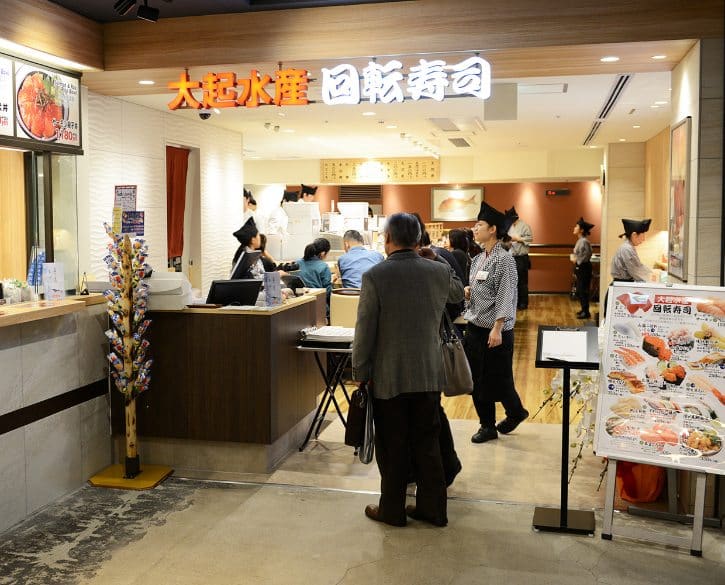
- What They Sell: Conveyor belt sushi (Kaitenzushi) located in the basement of Kyoto Tower. They serve fresh and affordable sushi.
- Must-Try Dishes: Fatty Pacific Bluefin Tuna, Aurora Salmon, Red Snow Crab, Grilled Eel, and Salmon Roe.
- Budget: Budget-friendly. Plates start from about ¥110 each, and a typical meal costs around ¥1,500 to ¥2,500 per person.
Day 5: Getting from Osaka to Kyoto
10:00 AM: Heading to Osaka
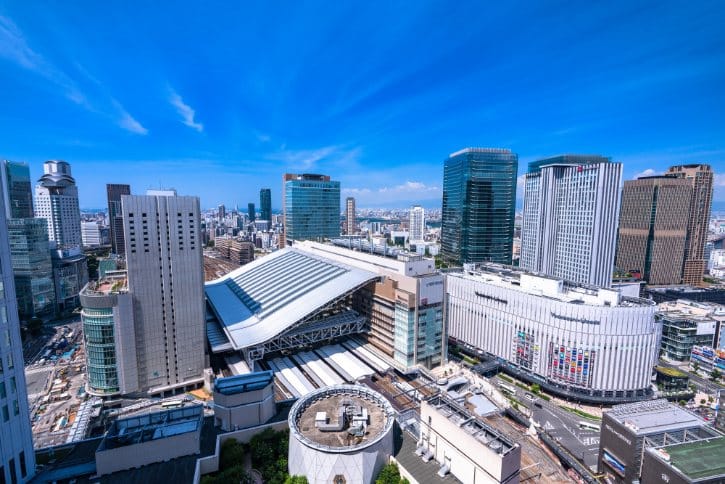
- At Osaka Station, get on the JR Kyoto Line’s Special Rapid Service train (Tokaido-Sanyo Main Line) going toward Kyoto.
- This train stops at only a few stations, including Shin-Osaka, Takatsuki, and Kyoto.
- Stay on the train until you arrive at Kyoto Station.
- The ride takes about 29 minutes and costs ¥580.
Why Choose the JR Kyoto Line (Tokaido-Sanyo Main Line)
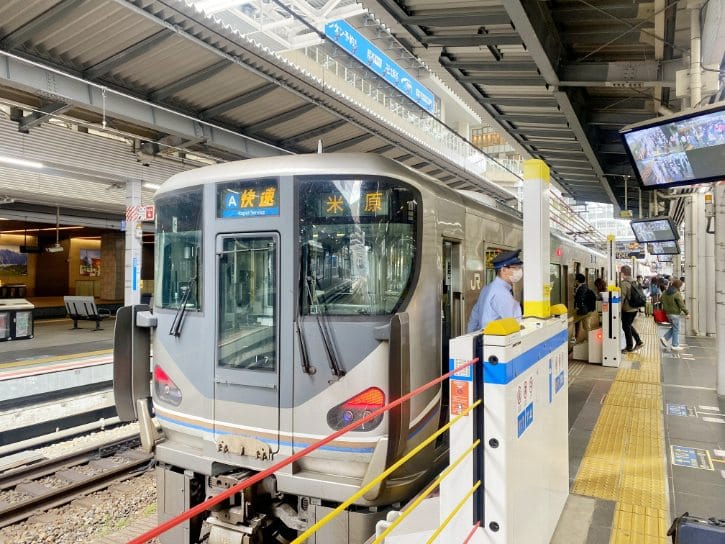
- Direct Access: You can travel directly from Osaka Station to Kyoto Station without changing trains.
- Train Type: Choose the “Special Rapid Service” train for the fastest trip.
- Journey Duration: It takes about 29 minutes.
- Stops: The train only stops at Osaka, Shin-Osaka, Takatsuki, and Kyoto.
- Affordability: The one-way ticket costs only ¥580, which is great value.
- Frequency: Trains leave every few minutes, so you won’t have to wait long.
Read More: Osaka to Kyoto: The Best Transport Options
10:30 AM: Hotel Check-in near Kyoto Station
a. Top Hotels Near Kyoto Station for Your Stay
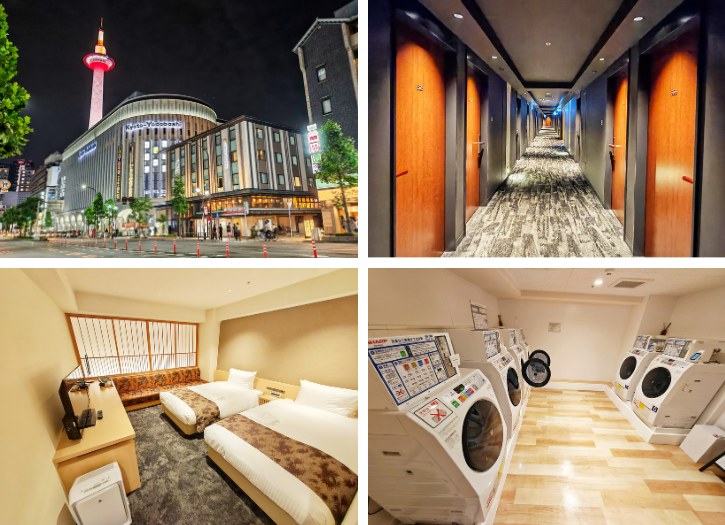
- Daiwa Roynet Hotel Kyoto Ekimae PREMIER (Booking.com | Agoda): Located just a 3–4 minute walk from JR Kyoto Station’s Central Exit, convenient if you’re carrying luggage. Easy access from Kansai International Airport via JR Haruka Express train (about 75 minutes) or airport bus (around 90 minutes). 24-hour coin laundry with automatic detergent available. FamilyMart and Lawson convenience stores nearby. I’ve stayed here and found it very comfortable and perfect for exploring Kyoto.
- Richmond Hotel Premier Kyoto Ekimae (Booking.com | Agoda): Modern hotel conveniently located near Kyoto Station. You’ll have easy access to transportation and popular attractions in the city.
- Hotel Hokke Club Kyoto (Booking.com | Agoda): Located just across from Kyoto Station, making transportation very convenient for your stay.
- TUNE STAY KYOTO (Booking.com | Agoda): A comfortable hotel about a 7-minute walk from Kyoto Station.
Read More: 5 Incredible Hotels in Osaka & Kyoto You Need to Know About
b. Great Reasons to Stay Near Kyoto Station
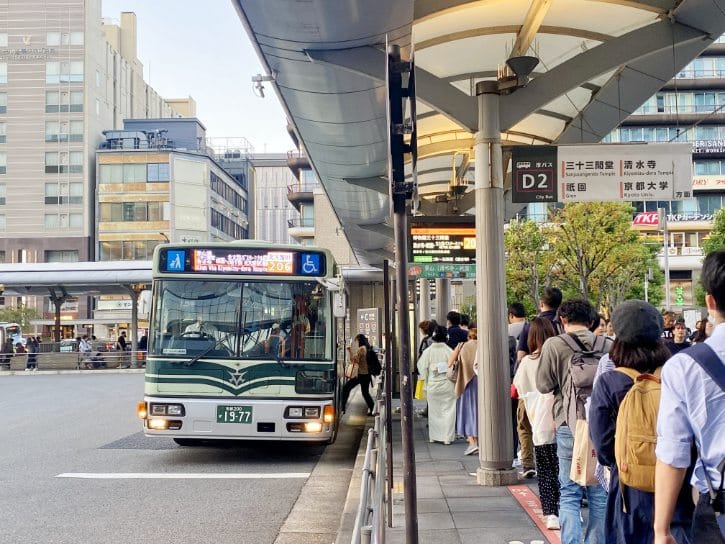
- Easy Access to Kansai Airport: You can easily travel between Kyoto and Kansai Airport using direct Haruka Express trains.
- Direct Trains to Osaka and Tokyo: Quickly reach major cities by taking the Shinkansen (bullet train) to Tokyo or the JR Kyoto Special Rapid Service train to Osaka.
- Convenient Bus Services: The Kyoto Station Bus Terminal offers many bus routes, making it simple for you to visit famous attractions around Kyoto.
Read More: Only 2 Best Places to Stay in Kyoto
11:30 AM: Arashiyama Bamboo Forest
a. Overview
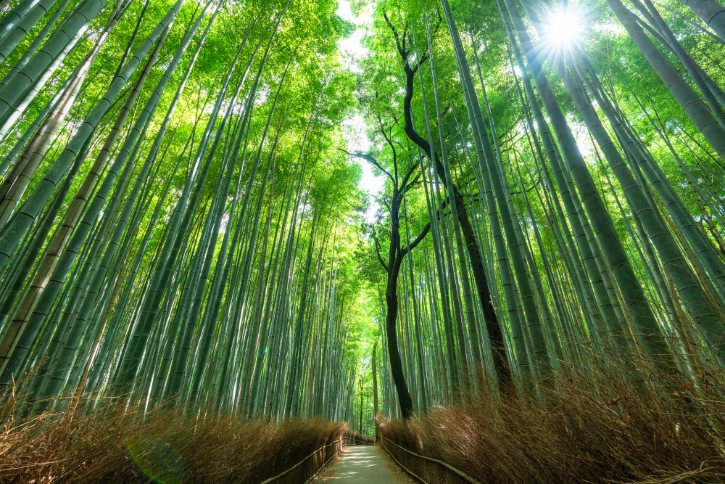
- What It Is: A beautiful, natural bamboo forest in the Arashiyama area of Kyoto. It has walking paths lined by tall bamboo stalks.
- History: This bamboo grove is hundreds of years old. In Japan, bamboo has always been important for building, crafts, and cooking.
- Why Visit: You’ll feel relaxed walking under the tall bamboo, enjoying the soft sunlight and peaceful rustling sounds. It’s also a great place for beautiful photos.
- Atmosphere: Quiet and relaxing, with bamboo forming a natural green roof above winding paths. It feels peaceful and calm.
b. Make the Most of Your Bamboo Grove Visit
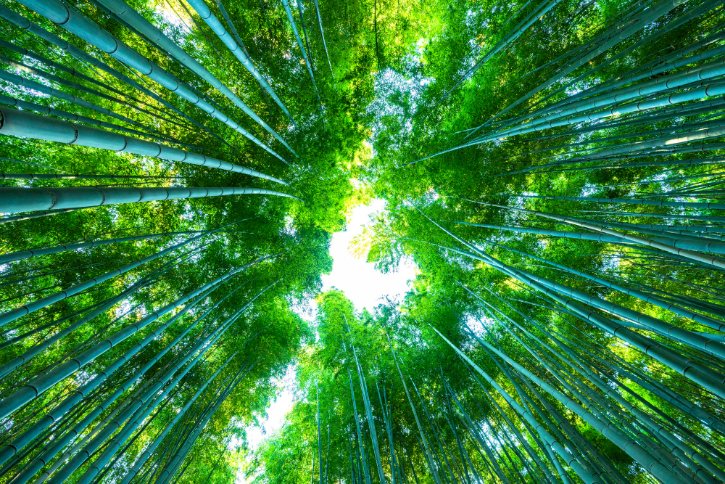
- Short Walk: Perfect if you’re looking for a short, 15–20 minute walk in nature.
- Look Up: Remember to look upward to appreciate how tall the bamboo grows.
- Listen Closely: Stop for a moment and listen to the gentle sound of bamboo leaves moving in the breeze.
- Take Your Time: Walk slowly, relax, and enjoy the peaceful atmosphere, even when it gets a little busy.
c. How to Get to Arashiyama Bamboo Forest from Kyoto Station
Take the JR San-In Line from Kyoto Station to Saga-Arashiyama Station for ¥240 in 18 minutes, then walk 10 minutes to Arashiyama Bamboo Forest.
12:00 PM: Tenryuji Temple
a. Overview

- What It Is: Tenryu-ji Temple is a famous Zen Buddhist temple in Kyoto. It’s a UNESCO World Heritage Site known for its beautiful garden and historic buildings.
- History: Built in 1339 by Shogun Ashikaga Takauji. It was rebuilt many times after fires, and most current buildings date from the Meiji Period.
- Why Visit: You’ll enjoy the beautiful garden created by Muso Soseki, with great views of the mountains. It’s a wonderful place to experience traditional Zen beauty away from busy tourist areas.
- Atmosphere: Calm and peaceful, ideal for relaxing and connecting with nature and Zen culture. It’s also great for photography, especially during spring blossoms or autumn leaves.
b. Don’t Miss These Temple Highlights
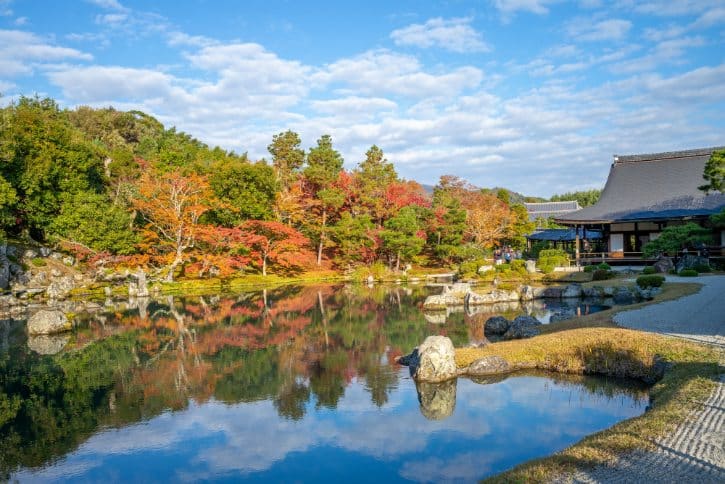
- Sogenchi Garden: Take a relaxing walk through this beautiful garden designed by Muso Soseki. You’ll see a tranquil pond right in the center.
- Hojo Visit: Go inside the Hojo building to enjoy its traditional architecture and lovely garden views.
- Hatto Hall: Don’t forget to look up inside Hatto Hall to see the impressive dragon painting on the ceiling.
c. How to Get to Tenryuji Temple from Arashiyama Bamboo Forest
It’s a 3-minute walk from Arashiyama Bamboo Forest to Tenryuji Temple.
1:30 PM: Arashiyama Yoshimura (Lunch)
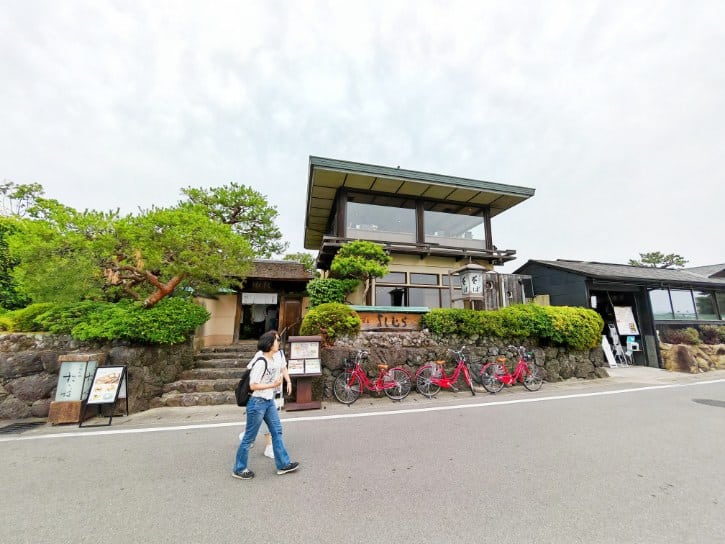
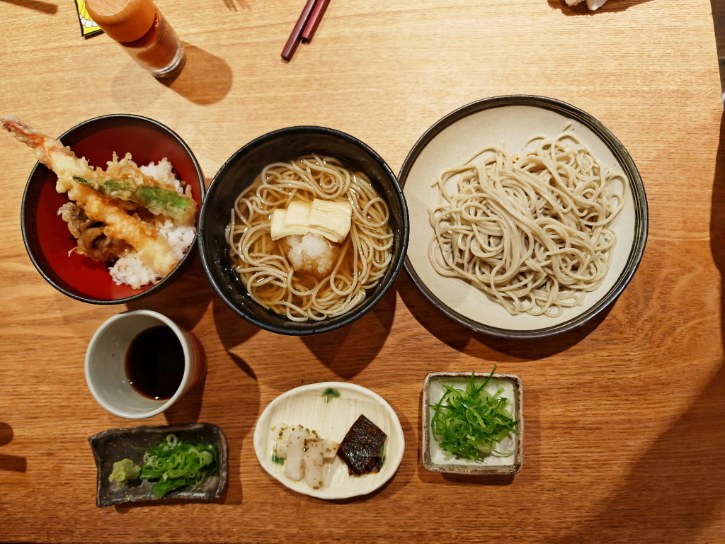
- What They Sell: Fresh, handmade soba noodles made daily at the restaurant, served either hot or cold.
- Must-Try Dishes:
- Togetsuzen Set: Try two types of soba noodles (Zaru and Yuba Oroshi), available hot or cold. This set also comes with a small bowl of crispy tempura rice and tasty soba koji pickles.
- Soba Tea Roll: A mini sponge cake roll flavored with roasted soba tea, filled with smooth cream made from fresh Hokkaido milk.
- Budget: About ¥1,800 to ¥3,000 per person.
How to Get to Arashiyama Yoshimura from Tenryuji Temple
It’s a 5-minute walk from Tenryuji Temple to Arashiyama Yoshimura.
2:30 PM: Togetsukyo Bridge
a. Overview
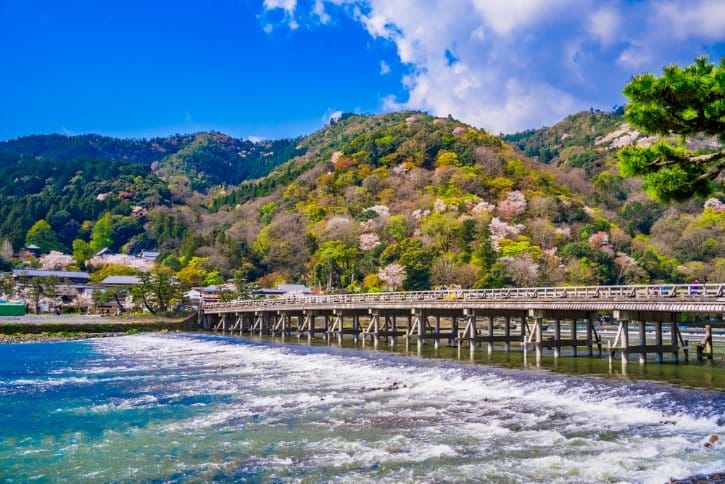
- What It Is: Togetsukyo Bridge (“Moon Crossing Bridge”) is a beautiful 155-meter bridge that crosses the Katsura River in Kyoto’s Arashiyama district. It’s built from reinforced concrete with traditional cypress wood railings.
- History: Originally built during the Heian Period (794–1185), the bridge was rebuilt several times after floods. Emperor Kameyama named it after seeing the moon appear to cross over it.
- Why Visit: You’ll enjoy wonderful views of the river and mountains, which are especially beautiful during cherry blossom season in spring and colorful leaves in autumn.
- Atmosphere: Relaxing and picturesque, with Arashiyama Mountain as a scenic background. It’s a peaceful spot to take a break from busy city areas and experience nature’s beauty through the changing seasons.
b. Top Experiences at Togetsukyo Bridge
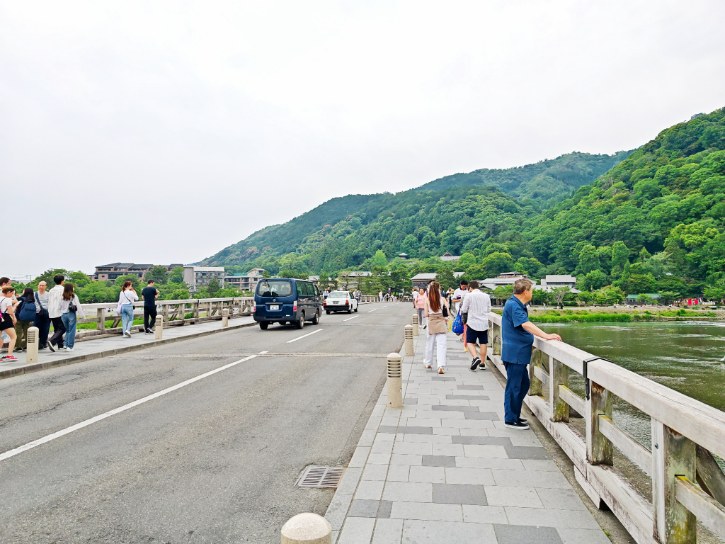
- Enjoy the Scenic Views: Take a relaxing walk across the 155-meter bridge and admire the views of Katsura River and Arashiyama Mountain. The scenery is especially beautiful during spring cherry blossoms and autumn leaves.
- Visit Local Shops and Eateries: Around the bridge, you’ll find many souvenir shops and restaurants. Take your time browsing unique gifts and tasting local snacks.
- Experience Seasonal Events: If you’re visiting in summer, you might see traditional cormorant fishing on the river. This is an interesting local tradition worth watching.
c. How to Get to Togetsukyo Bridge from Arashiyama Yoshimura
It’s a 1-minute walk from Arashiyama Yoshimura to Togetsukyo Bridge.
3:00 PM: Kimono Forest
a. Overview
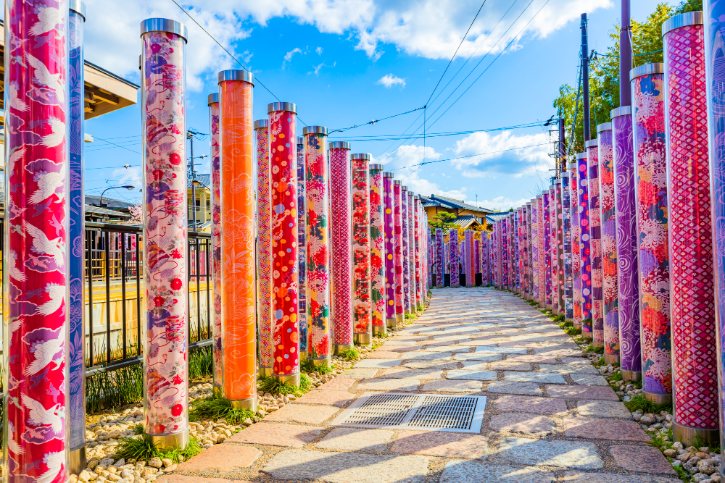
- What It Is: Kimono Forest is an art installation at Randen Arashiyama Station. It has transparent pillars filled with colorful kimono fabrics. At night, the pillars light up beautifully, making it a perfect place for photos.
- History: The installation was designed in 2013 by Yasumichi Morita. It blends traditional kimono patterns with modern design to celebrate Kyoto’s culture.
- Why Visit: You’ll see a unique mix of traditional fabrics and modern art. It’s an excellent spot to take memorable photos, especially after sunset.
- Atmosphere: During the day, you can enjoy vibrant kimono patterns. At night, the pillars glow magically. The area also includes the Dragon Pond with a reflective pool and sculpture.
b. Tips for Exploring Kimono Forest
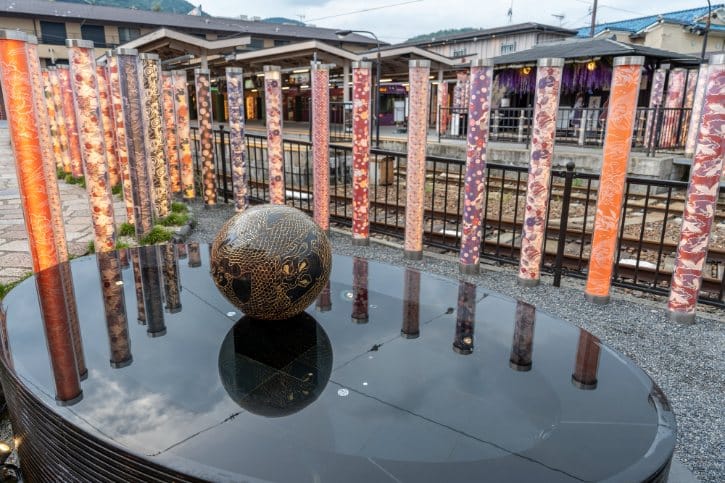
- Explore the Kimono Pillars: Walk around the station area to see the colorful kimono patterns inside each transparent pillar.
- Visit the Dragon Pond: At the end of the path, you’ll find Dragon Pond. Look for a black stone sphere engraved with a golden dragon. Making a wish here is believed to bring good luck.
- Relax at the Footbath: Take a break and soak your feet in the station’s relaxing footbath (ashiyu). It’s a nice way to rest during your visit.
c. How to Get to Kimono Forest from Togetsukyo Bridge
It’s a 3-minute walk from Togetsukyo Bridge to Kimono Forest.
4:00 PM: Fushimi Inari Taisha
a. Overview
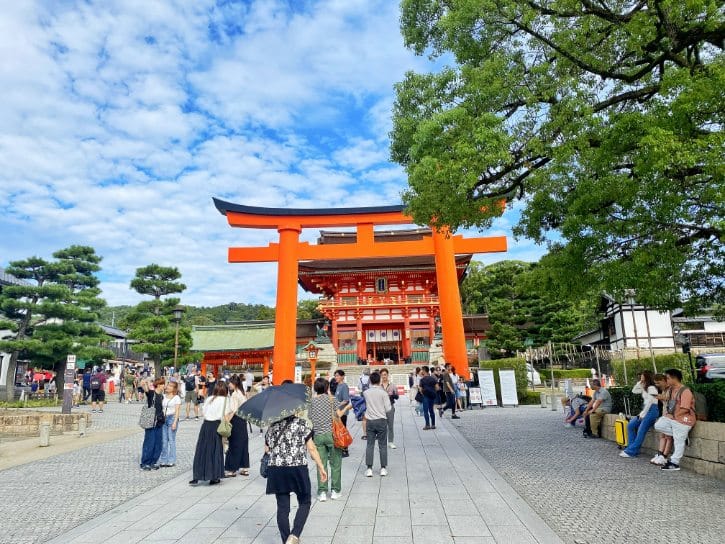
- What It Is: Fushimi Inari Taisha is a famous Shinto shrine in Kyoto dedicated to Inari, the god of rice and success. It’s well-known for thousands of bright orange torii gates that form a path up Mount Inari.
- History: Founded in the year 711, it’s one of Kyoto’s oldest shrines. Businesses donated the torii gates over many years, creating the impressive tunnels you see today.
- Why Visit: The shrine is free to enter and open 24 hours. Its unique torii gate tunnels are amazing for photos, especially in the early morning or late afternoon sunlight.
- Atmosphere: The shrine feels calm and spiritual. As you climb higher up the mountain, it gets quieter. Fox statues, considered Inari’s messengers, add a mysterious feeling.
b. Things to Do and See
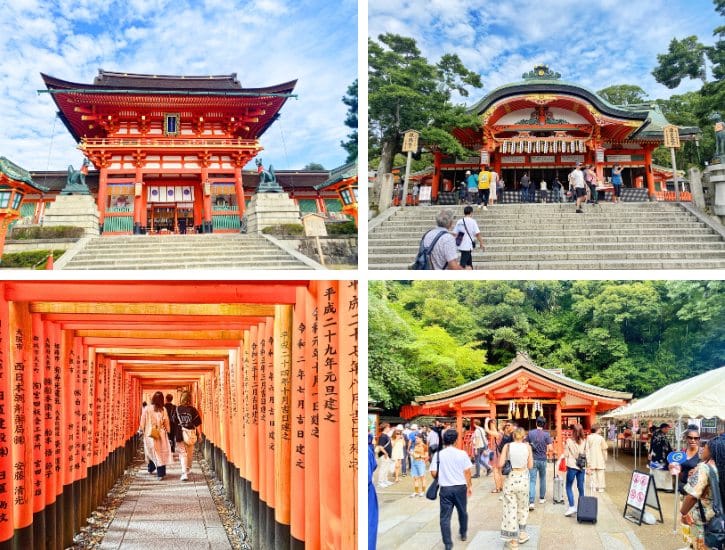
- Start at the Romon Gate: Begin your visit at the large red gate donated by Toyotomi Hideyoshi. It’s a perfect spot for photos and leads directly into the main shrine area.
- Explore the Main Shrine: Visit the main buildings, offer a prayer, and learn about Inari, the god of rice and business prosperity.
- Walk Through the Torii Gates: Walk through the famous red torii gates. Stay on the right side to avoid bumping into other visitors. Even a short walk gives you a memorable experience without hiking the entire path.
- Explore Side Trails: Take quieter side paths to smaller shrines for a peaceful break. Look for fox statues (Inari’s messengers) and stone lanterns along these trails.
c. How to Get to Fushimi Inari Taisha from Kimono Forest
Take the JR San-In Line from Saga-Arashiyama Station to Kyoto Station, then transfer to the JR Nara Line to Inari Station. The total trip takes about 25 minutes and costs ¥240. From Inari Station, it’s a 1-minute walk to Fushimi Inari Taisha.
7:00 PM: Dinner near or at Kyoto Station
a. Honke Daiichi-Asahi
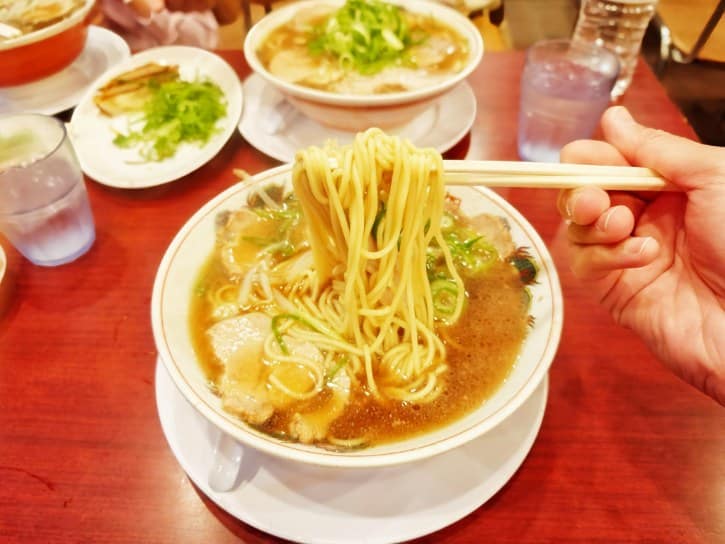
- What They Sell: Kyoto-style ramen with tasty pork broth, tender pork slices, and fresh green onions. They’re known for serving delicious and filling ramen.
- Must-Try Dishes:
- Tokusei Ramen (Special Ramen): Comes with extra pork slices and noodles, great if you’re hungry.
- Gyoza (Dumplings): Crispy dumplings filled with pork and vegetables. A perfect side dish.
- Budget: Regular ramen is ¥980, special ramen ¥1,180, and gyoza ¥320. Expect to spend about ¥1,000–¥1,500 per person.
b. Sushi no Musashi
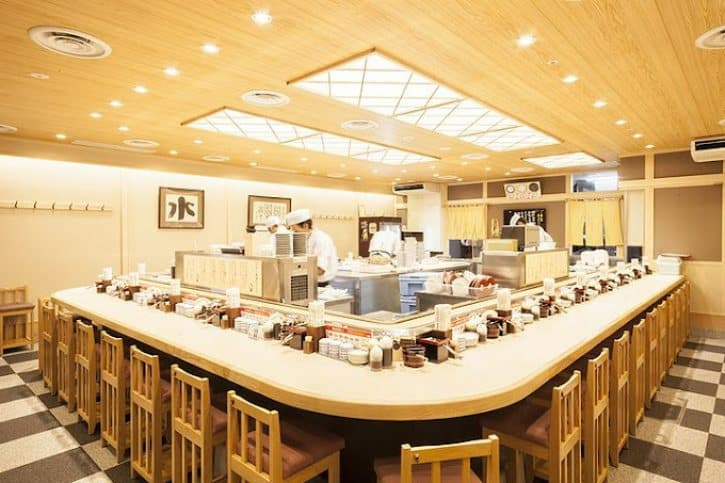
- What They Sell: Conveyor-belt sushi with about 50 types to choose from. It’s fresh, affordable, and has a relaxed atmosphere.
- Must-Try Dishes:
- Classic Nigiri: Try tuna, grilled salmon belly, and grilled eel.
- Chutoro (Fatty Tuna): Rich, buttery tuna that’s especially tasty.
- Tamago (Egg Omelette): Sweet, fluffy egg sushi that refreshes your palate.
- Budget: Most sushi plates cost ¥160, while premium plates are ¥400. Typical meals cost ¥1,000–¥2,000 per person.
c. Katsukura – Kyoto Porta
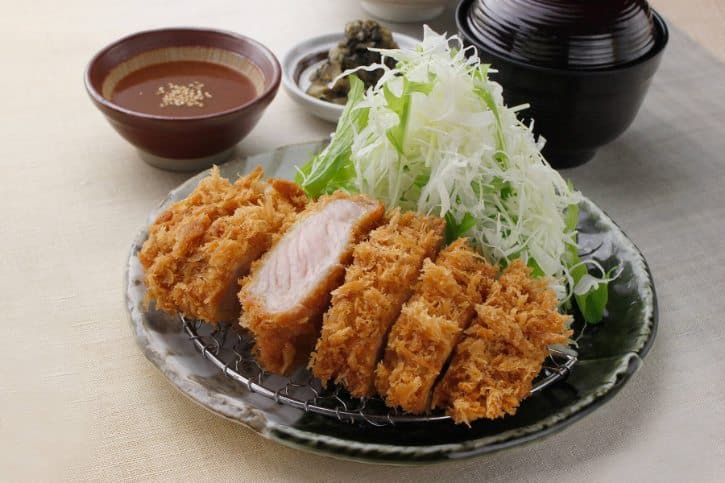
- What They Sell: Tonkatsu (fried pork cutlets) served as sets with rice, cabbage, and miso soup.
- Must-Try Dishes:
- Pork Loin Set (Kinkaton Rosu): Juicy pork loin with a little fat for extra flavor.
- Pork Fillet Set (Oebi to Hire Katsu): Combo set with a large fried prawn and tender pork fillet.
- Budget: Reasonably priced. Regular sets are about ¥1,700–¥1,800, while premium or combo sets cost ¥2,000–¥3,000. Sets include free refills of rice, miso soup, and cabbage.
How to Get to the Restaurants Above from Fushimi Inari Taisha
Take the JR Nara Line from Inari Station to Kyoto Station for ¥150 in 7 minutes.
Day 6: Kiyomizu-dera Temple, Yasaka Shrine, Hanamikoji Street, Kyoto Gion and Pontocho Alley
9:30 AM: Kiyomizu-dera Temple
a. Overview
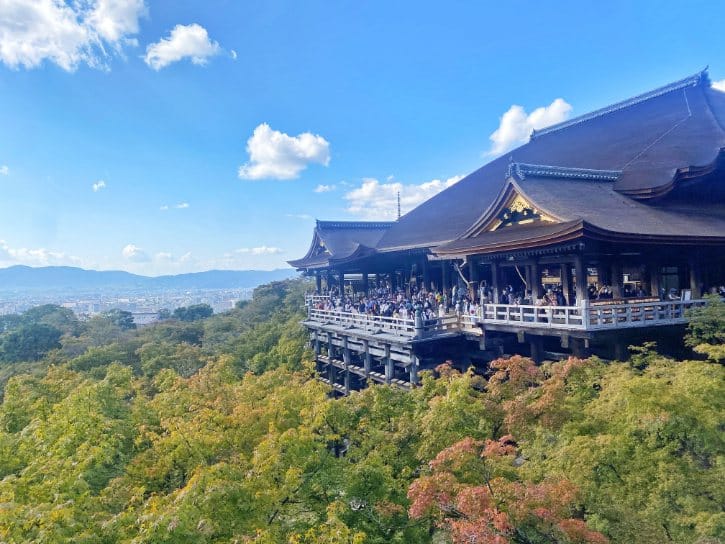
- What It Is: Kiyomizu-dera is a historic Buddhist temple in Kyoto, famous for its wooden stage extending over a hillside. It’s a UNESCO World Heritage site with beautiful views of the city.
- History: Founded in 778, with the current buildings dating back to the 17th century. The temple is dedicated to Kannon, the goddess of mercy, and is located in Kyoto’s Higashiyama cultural area.
- Why Visit: You can experience history, spirituality, and natural beauty in one place. The temple’s wooden stage is famous for being built without nails. It’s especially beautiful during cherry blossom and autumn leaf seasons.
- Atmosphere: Peaceful and calm, with the Otowa Waterfall nearby. The temple area is surrounded by traditional streets with many shops and tea houses.
b. Explore These Amazing Spots at Kiyomizu-dera Temple
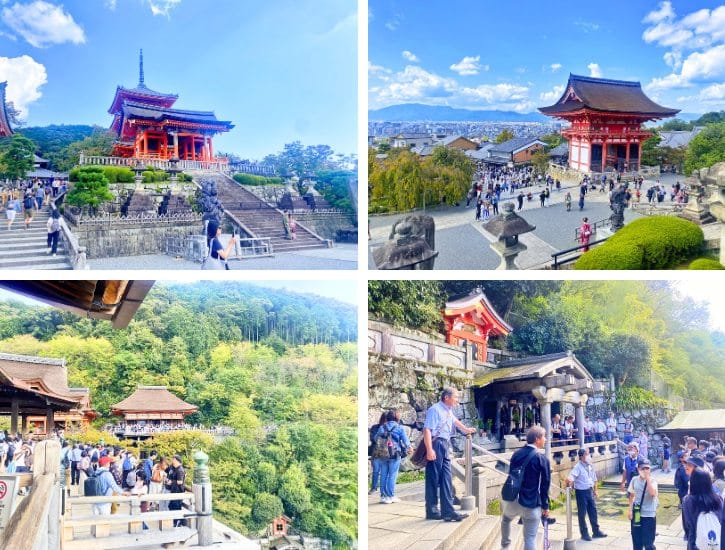
- Main Hall and Stage: Walk onto the famous wooden stage for amazing views of Kyoto. It’s especially beautiful for photos during spring cherry blossoms or autumn colors.
- Otowa Waterfall: Drink from one of the three sacred streams, each said to offer longevity, academic success, or love. Choosing all three is considered greedy, so just pick one!
- Three-Storied Pagoda: Take photos of one of Japan’s tallest pagodas (31 meters high). Its bright red color looks striking against Kyoto’s cityscape.
c. How to Get to Kiyomizu-dera Temple from Kyoto Station
Take Kyoto City Bus 206 from Kyoto Station to Kiyomizumichi bus stop for ¥230 (16 minutes), then walk 10 minutes to Kiyomizu-dera.
11:30 AM: Sannenzaka
a. Overview
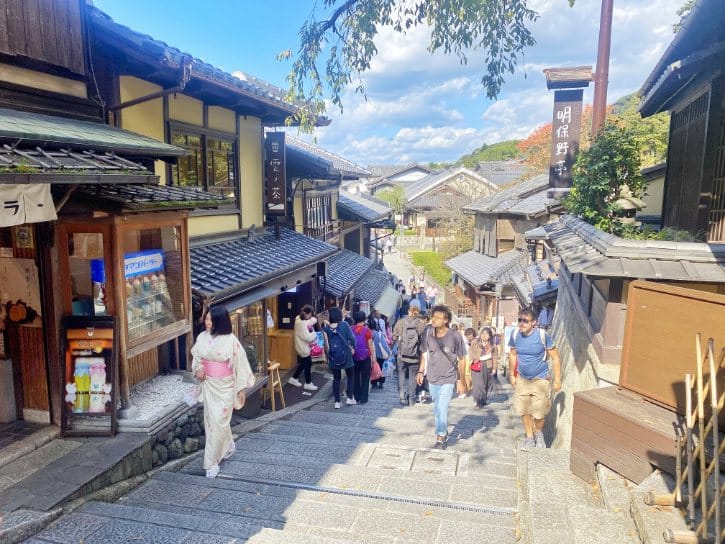
- What It Is: Sannenzaka is a historic sloped street in Kyoto’s Higashiyama area. Traditional wooden buildings and charming shops line the street, giving you a glimpse of old Kyoto.
- History: The street is over 1,000 years old and originally led to Kiyomizu-dera Temple. It’s known as the “Three-Year Slope” due to a local myth that if you fall here, you’ll have bad luck for three years, but that’s just a legend!
- Why Visit: You can experience the charm of traditional Kyoto, shop for unique souvenirs, taste local matcha sweets, and take beautiful photos of cobblestone streets and lantern-lit paths.
- Atmosphere: Walking here feels like going back in time. It’s lively and you’ll see a good mix of locals and tourists.
b. Delicious Local Foods You Should Try
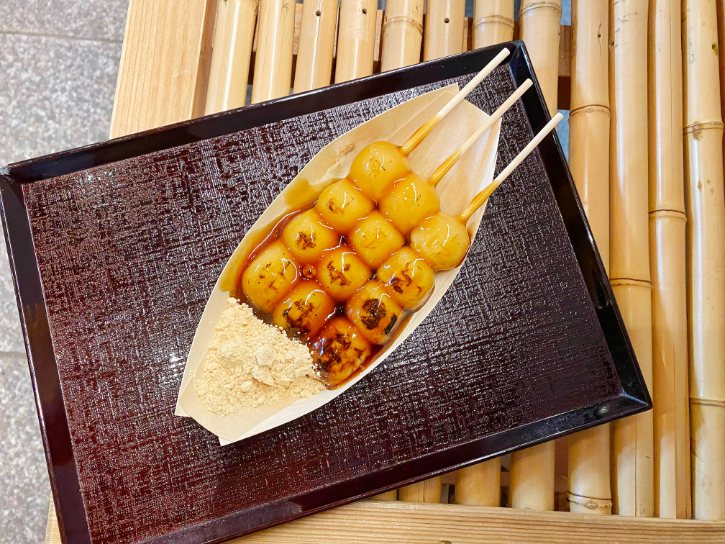
- Fujinami: Known for traditional Kyoto flavors. Try their iced matcha drink and soy sauce-flavored dango, which are popular treats.
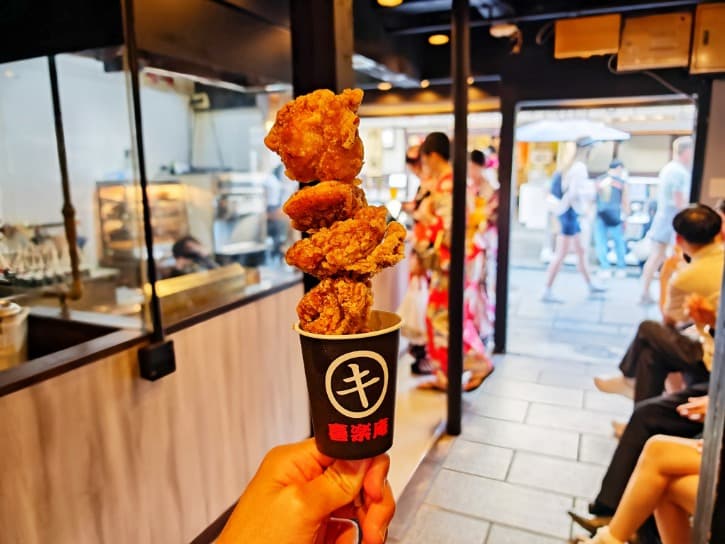
- Kirakuan Okamoto Sanneizaka: Famous for snacks called “Maiko-yaki”, shaped like apprentice geisha, with fillings such as red bean, cream, matcha, or ham and cheese. Their croquettes are tasty too.
- Okutan Kiyomizu: Specializes in handmade tofu dishes. Don’t miss their shaved ice dessert made from soy milk and black honey, praised for its rich, homemade taste.
- Ukiya Kiyomizu Kiseian: Popular for handmade soba noodles, but also known for delicious oyakodon. Try the crispy fried shrimp oyakodon, which is particularly tasty.
- Umezono Kiyomizu: Opened in 1927, this shop offers classic Japanese desserts like matcha sweets, shiratama zenzai (mochi in sweet red bean soup), warabi mochi, and seasonal desserts.
c. How to Get to Sannenzaka from Kiyomizu-dera Temple
It’s a 3-minute walk from Kiyomizu-dera Temple to Sannenzaka.
12:30 PM: Yasaka Pagoda
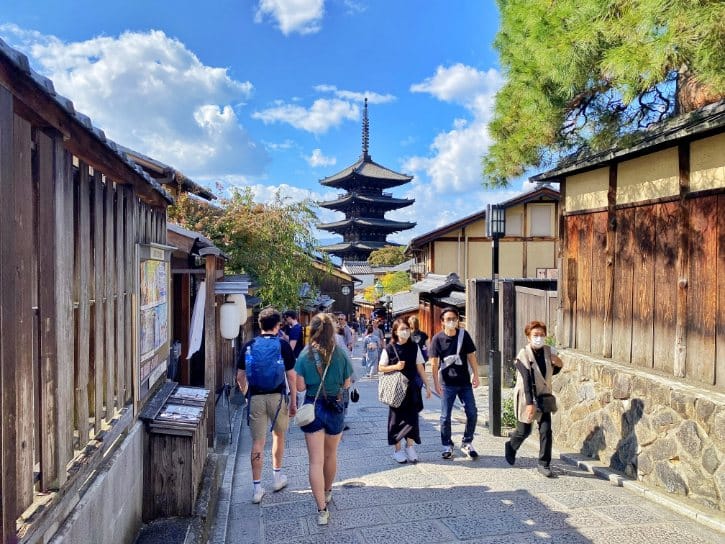
- What It Is: A historic five-story pagoda (Hokan-ji Temple) located in Kyoto’s Higashiyama district. It’s a famous landmark often seen in photographs and postcards.
- History: The pagoda is over 1,400 years old and was first built in the 6th century. Originally part of a larger temple area that no longer exists, it has been rebuilt many times after fires but still keeps its traditional look.
- Why Visit: It’s one of the most famous photo spots in Kyoto, offering a beautiful view with traditional streets around it.
- Atmosphere: Calm and peaceful, with the gentle sounds of wind chimes. Early mornings or evenings are especially nice when there are fewer visitors.
c. How to Get to Yasaka Pagoda from Sannenzaka
It’s a 3-minute walk from Sannenzaka to Yasaka Pagoda.
12:40 PM: Ninenzaka
a. Overview
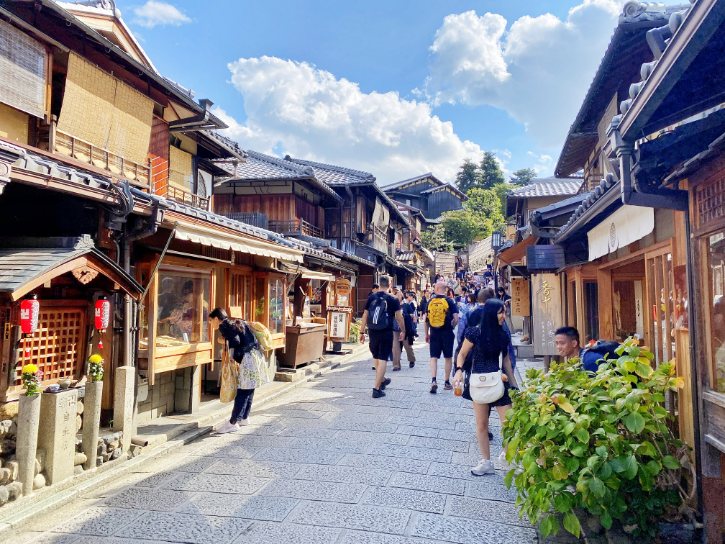
- What It Is: Ninenzaka is a charming historic pedestrian street in Kyoto. Traditional wooden houses and stone paths create a beautiful old-world atmosphere.
- History: The street dates back to the Edo period (1603–1868). Originally, it was a route for pilgrims visiting Kiyomizu-dera Temple. It’s called “Two-Year Hill” because of a local legend that falling here will bring two years of bad luck (just a myth!).
- Why Visit: You’ll see beautiful traditional Japanese architecture, find local handmade crafts, and enjoy delicious Kyoto food.
- Atmosphere: It has a nostalgic feel with carefully preserved buildings and no modern distractions like power lines. It’s perfect for a relaxing, scenic walk.
b. Best Spots to Enjoy Local Flavors
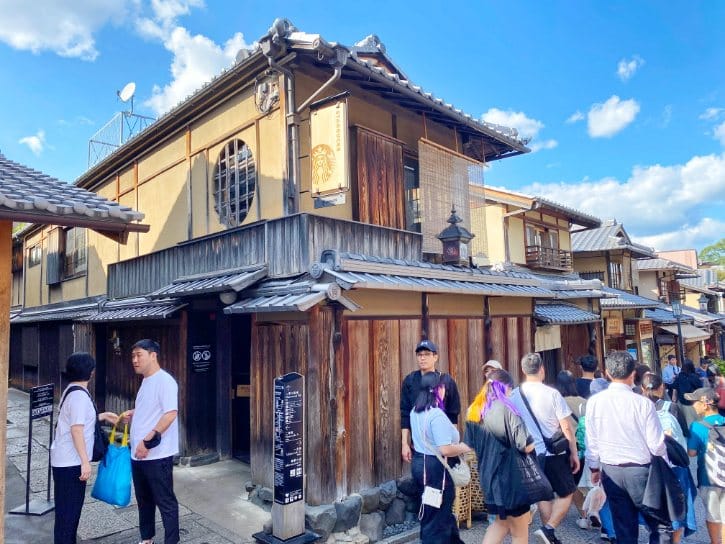
- Starbucks Kyoto Nineizaka Yasaka Chaya: A unique Starbucks with traditional tatami seating, mixing modern coffee culture with classic Japanese style.
- Ishidatami: Famous for premium soft-serve ice cream. Try their rich matcha flavor made with a special homemade sauce.
- Fujinami Kodai-ji Temple Store: Known for authentic Kyoto sweets, especially handmade dango and mochi prepared with high-quality ingredients.
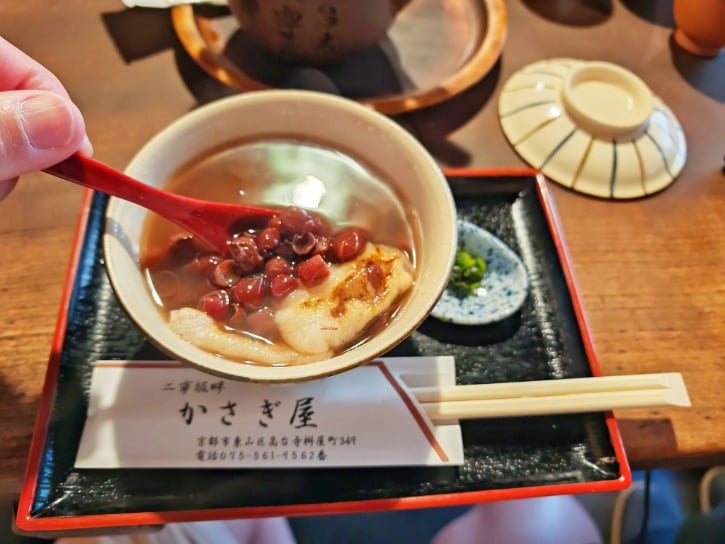
- Kasagiya: A historic sweets shop with a traditional atmosphere from the Taisho era. Popular treats include o-hagi (rice cakes) and zenzai (sweet red bean soup).
c. How to Get to Ninenzaka from Yasaka Pagoda
It’s a 2-minute walk from Yasaka Pagoda to Ninenzaka.
1:40 PM: Lunch in Kyoto Gion
a. Hisago
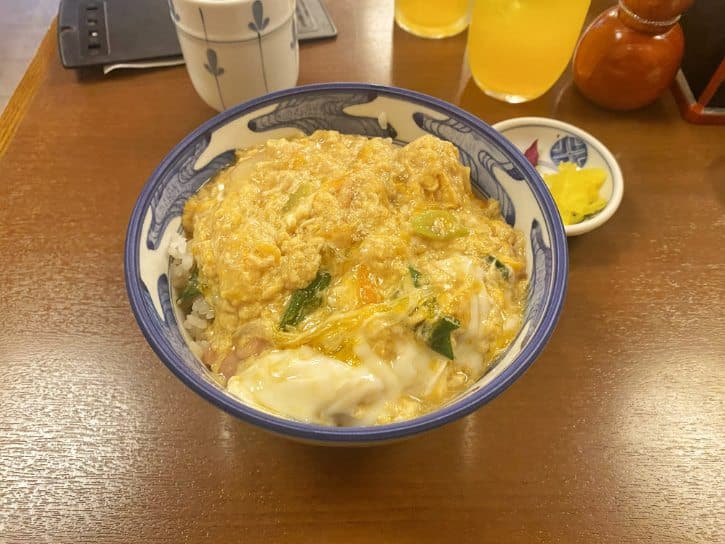
- What They Sell: Traditional Japanese rice bowls (donburi) and noodles.
- Must-Try Dishes: Oyakodon (rice bowl topped with chicken and egg), Nishin Soba (noodles served with simmered herring), Kitsune Udon (noodles topped with fried tofu).
- Budget: Dishes are around ¥1,000 each, typically under ¥2,000 per person.
b. Gyukatsu Kyoto Katsugyu – Gion Yasaka
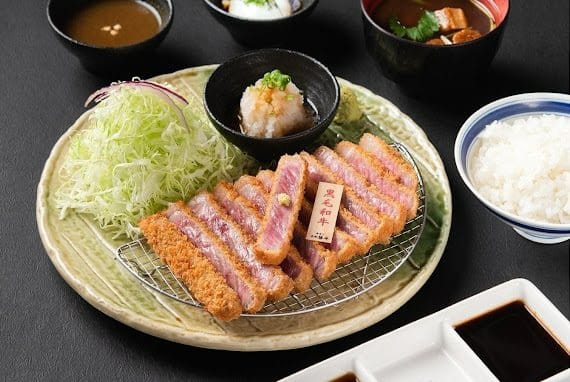
- What They Sell: Gyukatsu (deep-fried beef cutlets cooked medium-rare).
- Must-Try Dishes: Sirloin Gyukatsu Zen Set, featuring premium beef.
- Budget: About ¥2,000 to ¥3,000 per person.
How to Get to the Restaurants Above from Ninenzaka
It’s just a 2 to 10-minute walk from Ninenzaka to the restaurants listed above.
2:40 PM: Yasaka Shrine
a. Overview
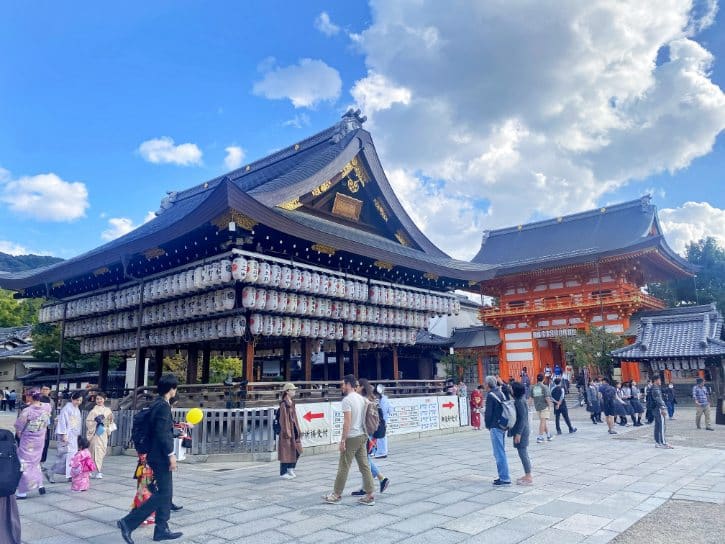
- What It Is: Yasaka Shrine (also known as Gion Shrine) is a famous historic Shinto shrine in Kyoto. It’s dedicated to Susanoo-no-Mikoto, a deity believed to protect against illnesses.
- History: The shrine is over 1,350 years old. It’s closely connected with the Gion Matsuri festival, which has been celebrated since 869 AD to pray for protection from diseases.
- Why Visit: You’ll see a beautiful red gate and main hall decorated with many lanterns. It’s especially beautiful at night.
- Atmosphere: It has a lively yet peaceful atmosphere. You’ll see locals praying and tourists exploring. At night, lanterns create a magical setting. The shrine area is especially lovely during cherry blossom season at nearby Maruyama Park.
b. Top Spots to Explore
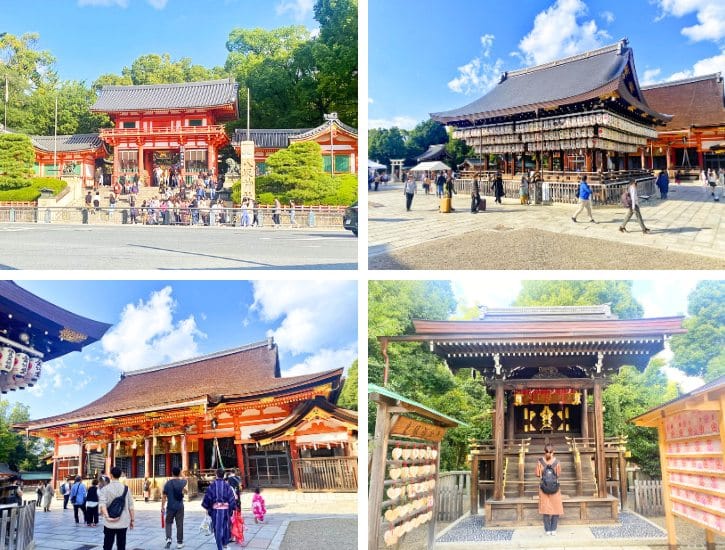
- Main Hall (Honden): The central area of the shrine, where you can pray. It features traditional architecture. To make a prayer, toss a coin, bow twice, clap twice, make your wish, then bow once more.
- Dance Stage (Kagura-den): Located directly in front of the main hall, this stage is decorated with hundreds of lanterns lit at night. Each lantern shows the name of a local business that donated it. The stage is used for traditional performances during festivals.
- Vermilion Entrance Gate (Nishiromon): This famous red gate marks the shrine’s western entrance and is a popular photo spot. It’s also a landmark of the Gion district.
- Maruyama Park: A peaceful park right next to the shrine. It’s especially beautiful during cherry blossom season (late March to early April), with many spots to relax.
- Beauty & Matchmaking Spots: At Utsukushii Gozen Shrine, you can splash “beauty water” for clear skin and good health. At Okuninushi Shrine, write your wishes for love and relationships on heart-shaped plaques.
c. How to Get to Yasaka Shrine from the Restaurants Above
It’s a 5-minute walk from the restaurants above to Yasaka Shrine.
4:00 PM: Hanamikoji Street
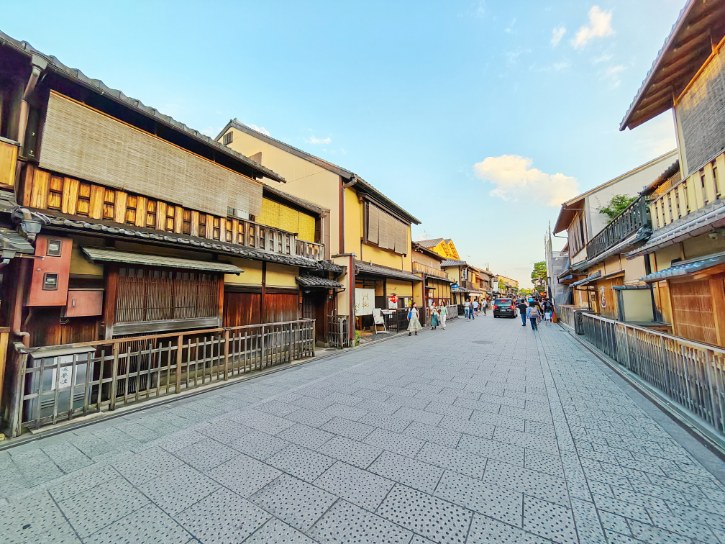
- What It Is: Hanamikoji Street is a beautiful, historic street in Kyoto’s Gion area. You’ll see traditional wooden houses, tea houses, and experience authentic geisha culture. It’s one of the best-preserved and most attractive areas in Kyoto.
- History: The street dates back to the Edo period (1603–1868). It’s famous for geiko (Kyoto’s geisha) and maiko (apprentice geisha). Tea houses here have hosted traditional performances for many years.
- Why Visit: You can soak up Kyoto’s traditional charm, stroll past historic buildings, and you might even see geiko or maiko dressed in beautiful kimonos. The area also has authentic tea houses and restaurants.
- Atmosphere: Elegant and peaceful, with stone-paved paths and traditional wooden houses. Lanterns glow in the evening, creating a special, historic feeling.
How to Get to Hanamikoji Street from Yasaka Shrine
It’s a 5-minute walk from Yasaka Shrine to Hanamikoji Street.
5:00 PM: Shirakawa Minami-dori
a. Overview
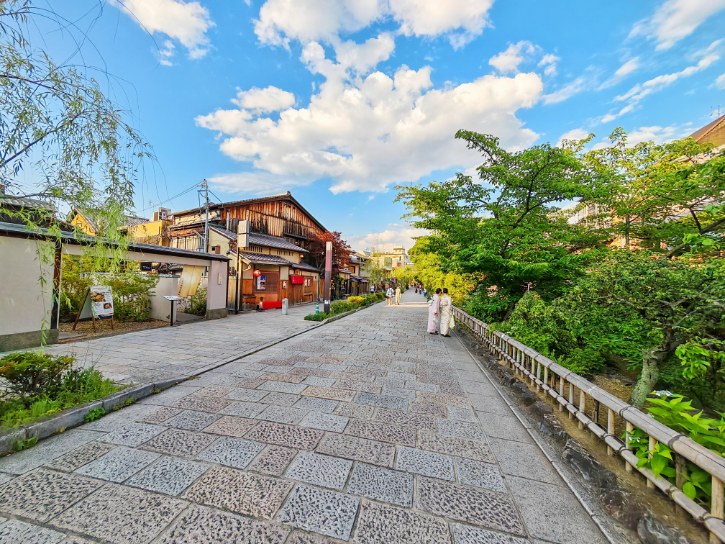
- What It Is: Shirakawa Minami-dori is a charming, quiet street along the Shirakawa Canal in Kyoto’s famous Gion district.
- History: This area was once known for traditional tea houses where geisha performed. Today, it’s protected as an important historic neighborhood. Tatsumi Daimyojin Shrine, dedicated to the goddess of arts and water, is located here.
- Why Visit: It’s one of the most beautiful streets in Kyoto, famous for cherry blossoms, traditional wooden buildings, stone bridges, and a peaceful atmosphere.
- Atmosphere: Calm, romantic, and traditional. It’s quieter than surrounding areas, making it perfect for relaxed walks and enjoying Kyoto’s historic charm.
b. Beautiful Places to See Along the Canal
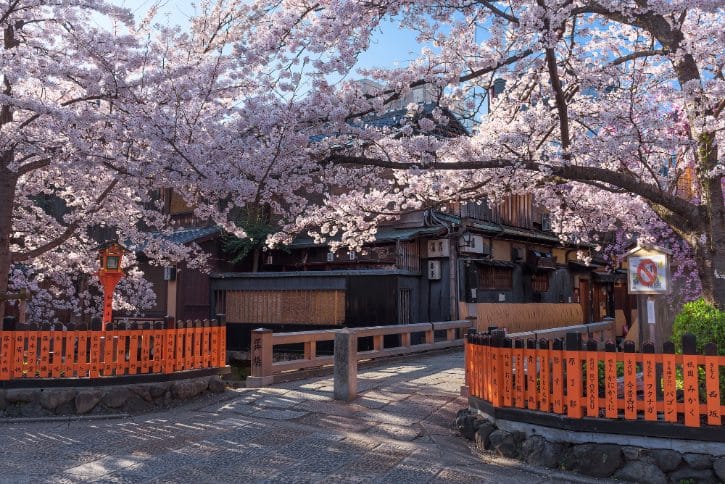
- Walk Along the Canal and Tatsumi Bridge: Take a leisurely walk along the canal lined with willow and cherry trees. The Tatsumi Bridge is a favorite spot for taking scenic photos.
- Visit Tatsumi Daimyojin Shrine: A small shrine popular with local geisha, dedicated to the goddess of arts and water. You can stop here briefly, offer a prayer, or simply enjoy its quiet charm.
c. How to Get to Shirakawa Minami-dori from Hanamikoji Street
It’s a 2-minute walk from Hanamikoji Street to Shirakawa Minami-dori.
6:00 PM: Teramachi Kyogoku Shopping Street
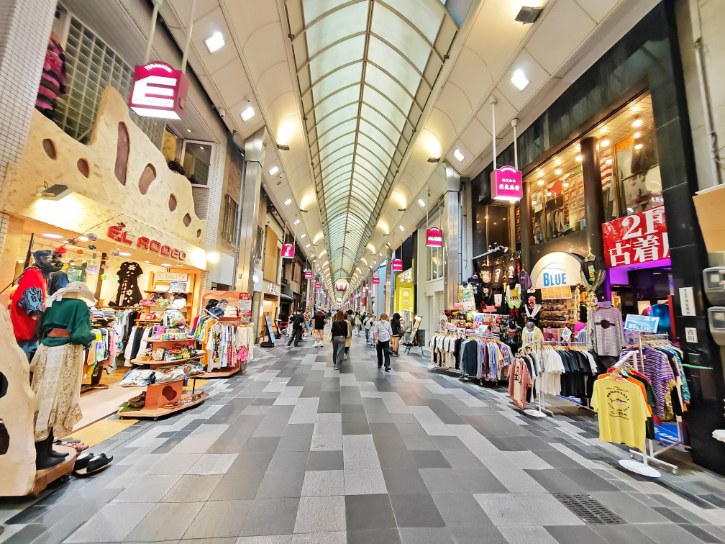
- What It Is: Teramachi Shopping Arcade is a covered shopping street in Kyoto. It offers a mix of traditional and modern shops selling souvenirs, clothes, and local food.
- History: It was established in the 16th century by warlord Toyotomi Hideyoshi. The area was called “Temple Town” because Hideyoshi moved many temples here.
- Why Visit: You can enjoy Kyoto’s history while shopping. Find special handmade fans at Hakuchikudo, and try tasty local dishes at places like Kyo Tsuke-men Tsurukame and Moritoshi.
- Atmosphere: Relaxed and welcoming, with colorful storefronts. It’s popular among both locals and tourists, making it great for casual shopping.
How to Get to Teramachi Kyogoku Shopping Street from Shirakawa Minami-dori
It’s a 12-minute walk from Shirakawa Minami-dori to Teramachi Kyogoku Shopping Street.
7:30 PM: Pontocho Alley

- What It Is: Pontocho is a narrow, 500-meter-long alley in Kyoto that runs next to the Kamo River. It’s known for traditional wooden teahouses, high-quality restaurants, and historic geisha culture.
- History: The alley dates back to the 1670s. It became an entertainment area with teahouses and places for geisha performances, playing an important role in Kyoto’s cultural history.
- Why Visit: You’ll get a peek into Kyoto’s rich past. It’s also a good spot to see geisha and maiko (apprentice geisha). You’ll find plenty of places to eat, ranging from casual grilled skewers (yakitori) to elegant kaiseki restaurants, some with riverside views.
- Atmosphere: At night, the alley is beautifully lit by lanterns, giving it a magical feel. Its narrow paths create a cozy atmosphere, making it perfect for evening walks and taking great photos.
How to Get to Pontocho Alley from Teramachi Kyogoku Shopping Street
It’s a 5-minute walk from Teramachi Kyogoku Shopping Street to Pontocho Alley.
8:00 PM: Dinner near Pontocho Alley
a. Kappa Sushi
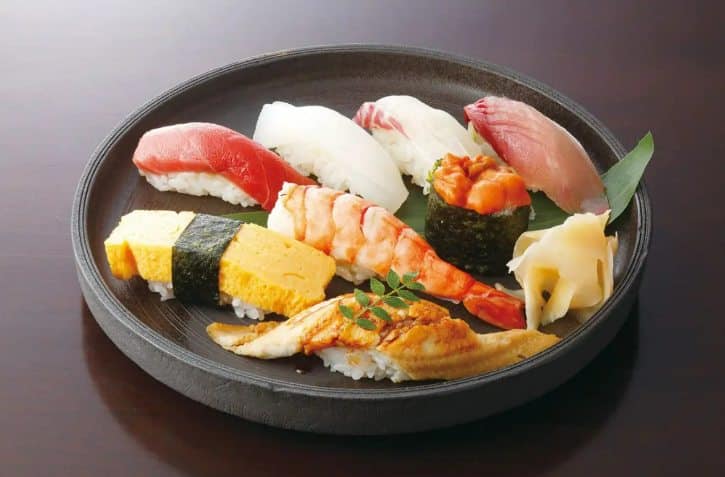
- What They Sell: Fresh sushi, especially traditional hand-pressed sushi (nigiri).
- Must-Try Dishes: Try the Rich Southern Bluefin Tuna, Red Sea Bream with citrus, Fresh Yellowtail, Big Shrimp, and Hokkaido Abalone.
- Budget: Around ¥1,500 to ¥2,500 per person.
b. Kichi Kichi Omurice
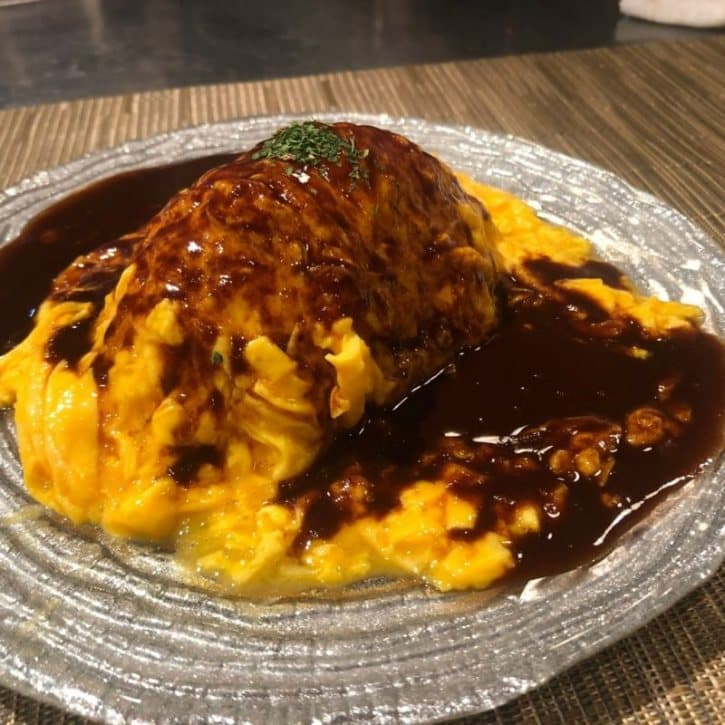
- What They Sell: Famous for Japanese-style omelette rice (omurice) and hearty beef stew.
- Must-Try Dishes: Order their signature Omurice with a delicious demi-glace sauce. The beef stew is also excellent.
- Budget: Omurice costs about ¥3,000 (full size) or ¥1,600 (half size). Beef stew is around ¥3,800.
c. Kyoto Yakiniku Hiro Pontocho
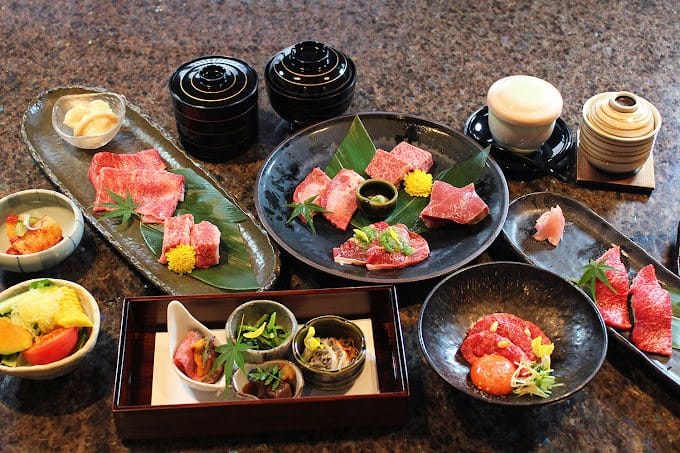
- What They Sell: Japanese-style barbecue (yakiniku) with high-quality wagyu beef that you grill yourself at your table.
- Must-Try Dishes: Choose a wagyu beef course menu to try the best variety. Popular dishes include the tender “Hana-saki Momo”, lightly grilled sirloin, and spicy marinated horumon (beef offal).
- Budget: About ¥3,000 to ¥5,000 per person. Course menus cost between ¥6,000 and ¥10,000.
Day 7: Kinkakuji Temple, Nijo Castle, Nishiki Market, Shijo and Kawaramachi Streets
9:30 AM: Kinkakuji
a. Overview

- What It Is: Kinkakuji is a Zen Buddhist temple in Kyoto, famous for its top two floors covered entirely in gold leaf. It’s a UNESCO World Heritage Site and one of Kyoto’s most famous landmarks.
- History: The temple was originally built in 1397 as a retirement home for a shogun, then later turned into a Zen temple. The current building is a reconstruction from 1955, after the original burned down in 1950.
- Why Visit: It’s a must-see for its stunning beauty and peaceful atmosphere. The reflection of the gold-covered building on the pond is unforgettable, especially on sunny days. It’s a great example of traditional Japanese architecture and Zen garden design.
- Atmosphere: The temple grounds feel calm and peaceful, with lovely gardens and easy walking paths. Even when it’s crowded, you can comfortably enjoy the views without feeling rushed.
b. Highlights You Shouldn’t Miss at Kinkakuji
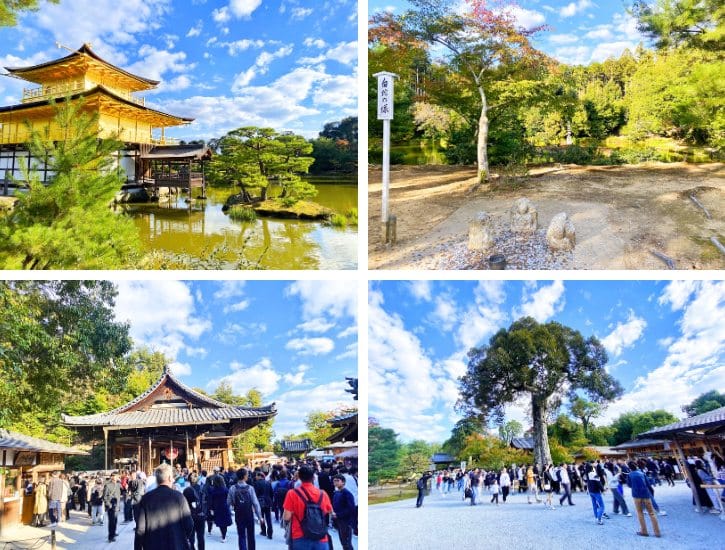
- Coin Tossing for Luck: At Anmintaku Pond, look for small statues. Toss coins into the bowl at the statues’ base and make a wish for protection and good luck.
- Admire the Golden Pavilion’s Reflection: Spend some time enjoying the beautiful reflection of the temple on Kyoko-chi Pond. It’s especially stunning on calm days when the water mirrors the building clearly.
- Explore the Gardens: Walk through the carefully designed gardens around the pavilion. Follow the path around the pond for different views of the temple and its reflection.
- Anmintaku Pond: Visit this peaceful pond that never dries out. In the center, you’ll see a small island dedicated to the white snake, a symbol of water. You can also see a five-ringed pagoda monument in the pond.
c. How to Get to Kinkakuji from Kyoto Station
Take Kyoto City Bus 205 from Kyoto Station to Kinkakuji-michi bus stop for ¥230 (40 minutes), then walk 2 minutes to Kinkakuji.
11:00 AM: Nijo Castle
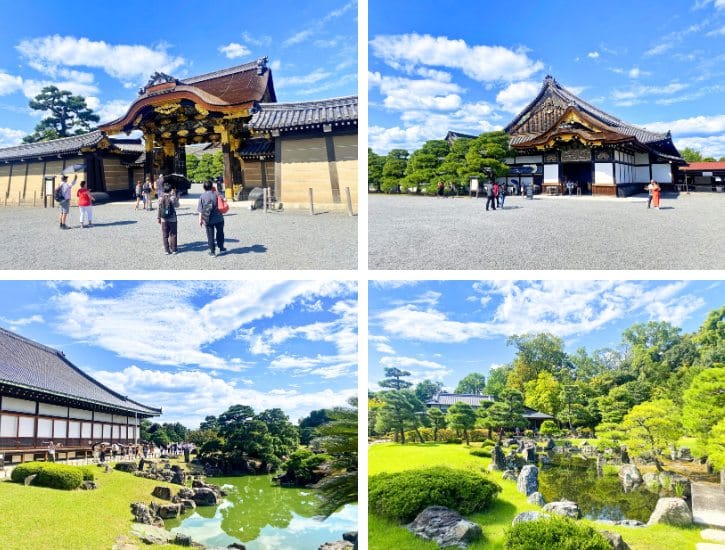
- What It Is: Nijo Castle is a historic castle in Kyoto, built in 1603. It was the home of the first Tokugawa shogun and is now a UNESCO World Heritage Site.
- History: It served as the Kyoto home for the Tokugawa shoguns. In 1867, the last shogun announced here that power would return to the emperor, marking the end of shogun rule in Japan.
- Why Visit: You can experience the unique “nightingale floors” that make chirping sounds when you walk on them. You’ll also see detailed wood carvings and beautifully decorated panels throughout the castle.
- Atmosphere: The castle has lovely Japanese gardens, including Ninomaru Garden designed by Kobori Enshu. The gardens are especially beautiful during cherry blossom season and when maple and ginkgo leaves change colors in autumn.
How to Get to Nijo Castle from Kinkakuji
Take Kyoto City Bus 12 from Kinkakuji-michi bus stop to Horikawamarutamachi bus stop for ¥230 (18 minutes), then walk 7 minutes to Nijo Castle.
1:30 PM: Lunch near Nishiki Market
a. Gyukatsu Kyoto Katsugyu (Kawaramachi)
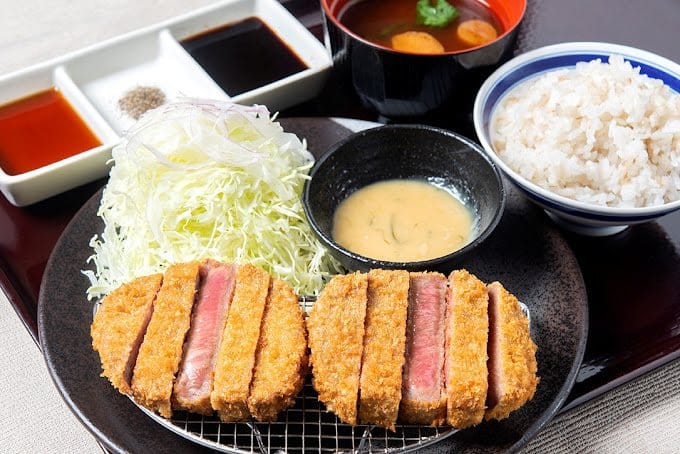
- What They Sell: Crispy beef cutlets (“Gyukatsu”) that are crunchy on the outside and juicy on the inside. They’re served in sets with rice, cabbage, soup, and tasty dipping sauces.
- Must-Try Dishes: Sirloin Gyukatsu Set and Tenderloin Gyukatsu Set.
- Budget: Around ¥2,000–¥3,000 per person.
How to Get to Gyukatsu Kyoto Katsugyu from Nijo Castle
Take Kyoto City Bus 12 from Horikawa Oike bus stop to Shijo Kawaramachi bus stop for ¥230 (12 minutes), then walk 2 minutes to Gyukatsu Kyoto Katsugyu.
b. Unagi Sora
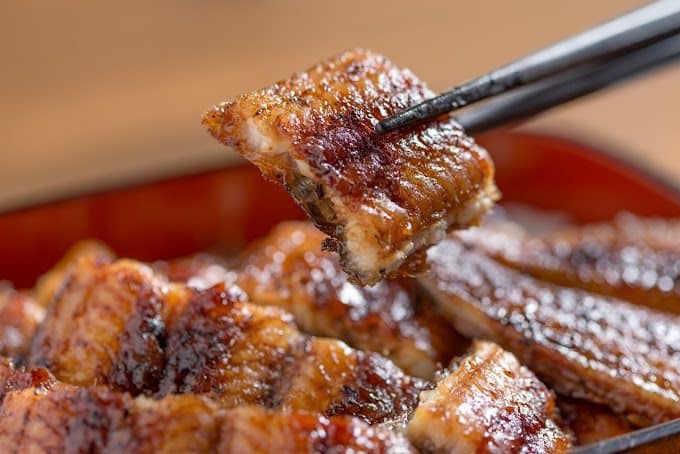
- What They Sell: Delicious grilled freshwater eel (“Unagi”) cooked over charcoal and served on rice with a special sauce.
- Must-Try Dishes: Unaju (Eel Rice Box), made with premium eel that’s rich, soft, and full of flavor.
- Budget: About ¥4,000–¥7,000 per person.
How to Get to Unagi Sora from Nijo Castle
Take Kyoto City Bus 12 from Horikawa Oike bus stop to Shijo Takakura bus stop for ¥230 (9 minutes), then walk 5 minutes to Unagi Sora.
2:30 PM: Nishiki Market
a. Overview
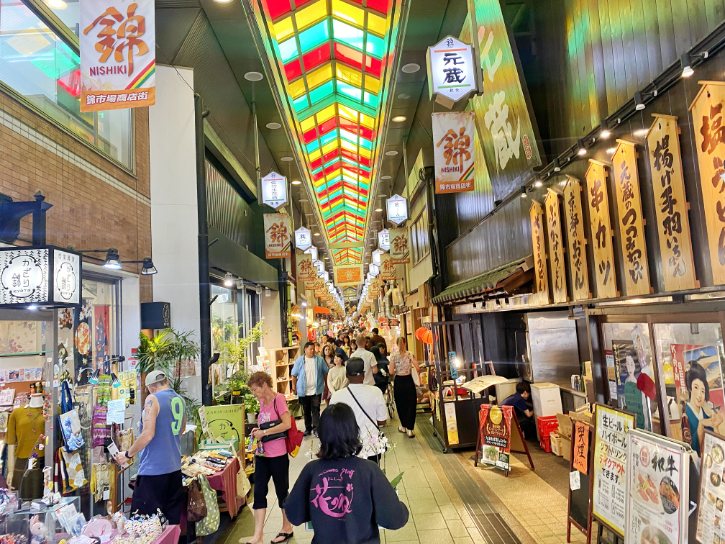
- What It Is: Nishiki Market is a narrow shopping street known as “Kyoto’s Kitchen”. It has over 100 food shops and restaurants, selling fresh seafood, produce, kitchen tools, knives, and Kyoto specialties.
- History: The market is over 400 years old. It started as a fish market in the early 1600s because the area’s cool groundwater kept fish fresh. Over time, it grew to include many other food products.
- Why Visit: You can explore Kyoto’s local food culture, taste delicious street food like grilled meats, tamago, and mochi, and try local treats like matcha sweets and rolled omelets (tamagoyaki).
- Atmosphere: Nishiki Market is a lively covered market full of energy. You’ll enjoy the colorful displays and bustling atmosphere, mixing tradition and excitement.
b. Delicious Local Foods to Try
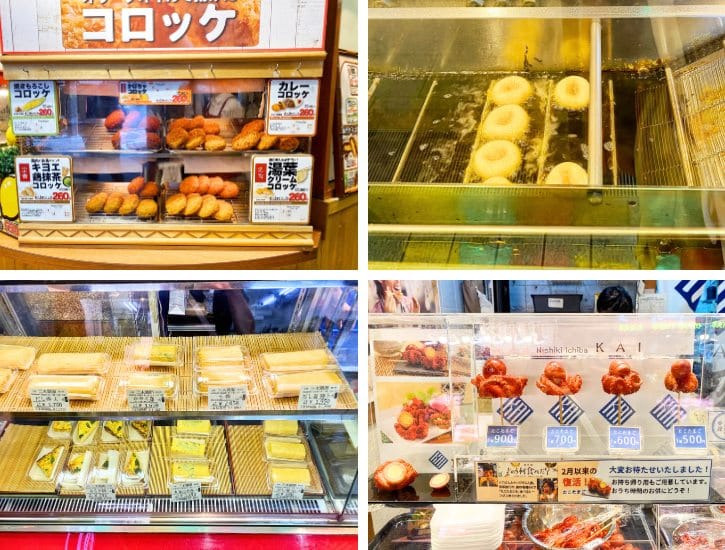
- Yuba Cream Croquette (Hanayori Kiyoe): Crispy croquettes made with tofu skin (yuba) and creamy filling. They have a delicious crunchy outside and a soft inside.
- Soy Milk Doughnuts (Konna Monja): Fresh, fluffy doughnuts made with soy milk. They’re lightly sweet and taste best when warm.
- Dashimaki Tamago – Rolled Omelet (Miki Keiran): A tasty rolled omelet made from fresh eggs and flavorful dashi broth. Popular with both locals and visitors.
- Tako Tamago – Octopus with Quail Egg (Kai): A special snack of small octopus stuffed with boiled quail egg, then grilled with a tasty glaze.
- Unagi – Grilled Eel (Ajisai no Toyo): Charcoal-grilled eel with a sweet soy sauce glaze, served over rice.
How to Get to Nishiki Market from the Restaurants Above
It’s just a 1 to 5 minute walk from the restaurants listed above to Nishiki Market.
4:30 PM: Nishiki Tenmangu Shrine
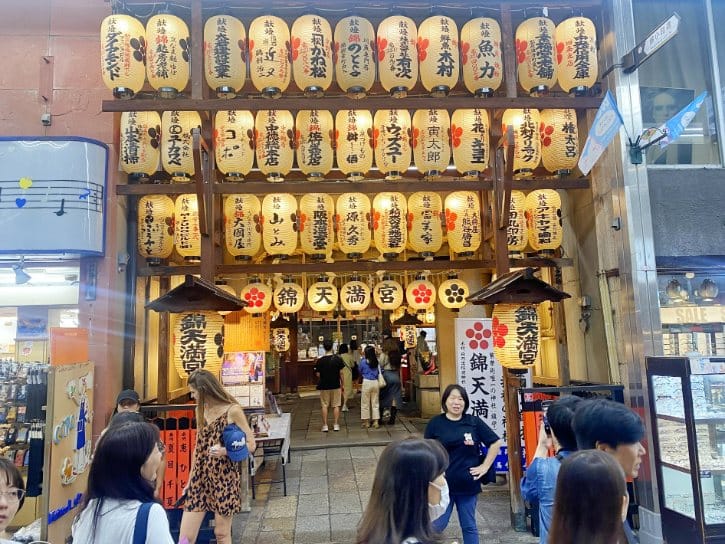
- What It Is: Nishiki Tenmangu is a small, historic Shinto shrine located at the east end of Nishiki Market. It’s dedicated to Sugawara no Michizane, a god of learning and education. Many students visit to pray for good grades and exam success.
- History: The shrine was established in 1003 to honor Sugawara no Michizane, who was a famous scholar and politician.
- Why Visit: It’s a peaceful spot for a short break while exploring Nishiki Market. You can also pray here for success in your studies or exams. Its small size makes it an easy but meaningful place to visit.
- Atmosphere: The shrine is unique because its traditional torii gate blends into the surrounding buildings. You’ll see traditional lanterns and the “Nishiki no Mizu”, a natural spring known for its pure water that’s believed to bring good luck.
How to Get to Nishiki Tenmangu Shrine from Nishiki Market
Nishiki Tenmangu Shrine is located at the eastern end of Nishiki Market.
5:00 PM: Shijo and Kawaramachi Streets
a. Overview
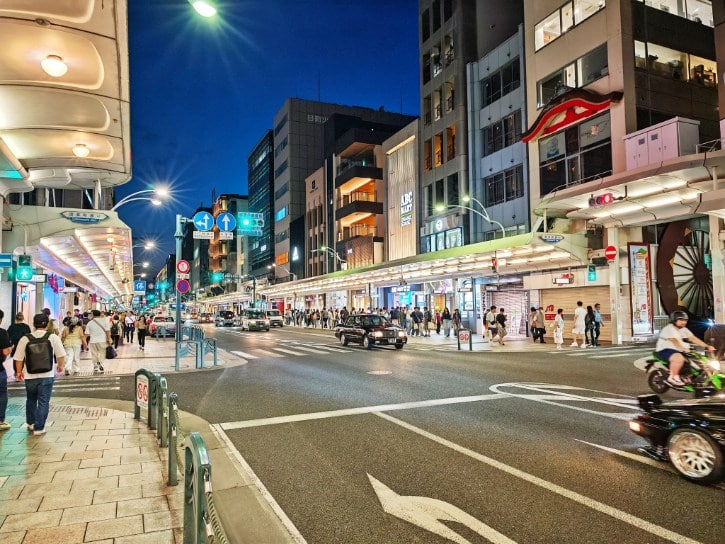
- What It Is: Shijo Kawaramachi is Kyoto’s main shopping and entertainment area, located at the intersection of Shijo Street (running east-west) and Kawaramachi Street (running north-south).
- History: Shijo Street has been Kyoto’s main shopping street since ancient times. Kawaramachi Street developed from the late 1500s, and by the 1900s, this area became Kyoto’s busiest district.
- Why Visit: You can easily walk to Nishiki Market, Gion, and Kamogawa River. You’ll find many shopping, dining, and cultural experiences all in one place.
- Atmosphere: The main streets are modern, busy, and filled with shoppers, especially in the afternoon and evening. Department stores and neon-lit shops line the streets, while smaller side streets have a more traditional feel.
b. Upscale and Luxury Shopping Spots
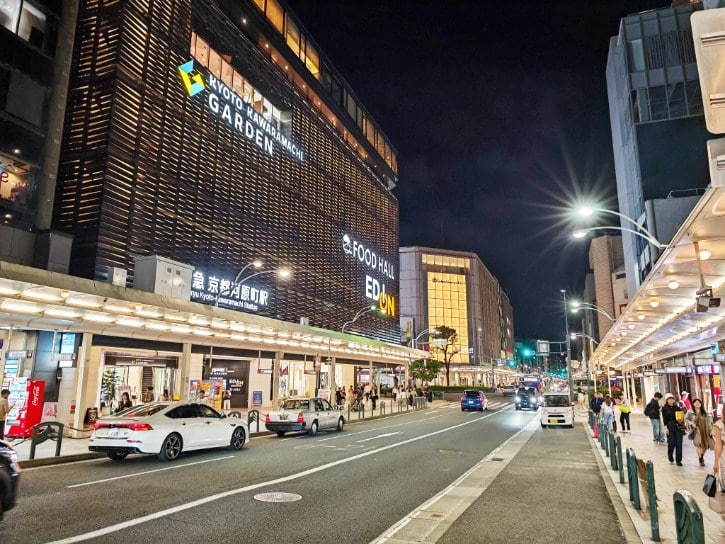
- Kyoto Kawaramachi Garden: A modern shopping center near Takashimaya, offering trendy fashion and restaurants.
- Kyoto Takashimaya: Famous upscale department store located at the main intersection. You can shop for luxury brands, cosmetics, souvenirs, and gourmet foods. It also has an official Nintendo Store selling exclusive merchandise.
- Daimaru Kyoto: Another high-end department store on Shijo Street, selling luxury fashion, beauty products, and delicious food at its large food hall.
- Kyoto BAL: A fashionable shopping center on Kawaramachi Street, featuring luxury boutiques in a modern, stylish setting.
c. Trendy Shops Popular with Young Shoppers
- Fujii Daimaru: Popular among younger shoppers, offering fashionable clothes and unique items. It’s located on Shijo Street.
- Kawaramachi OPA: A multi-level shopping mall selling affordable fashion, accessories, and second-hand media, ideal for teens and young adults.
d. Best Budget-Friendly Shops and Markets
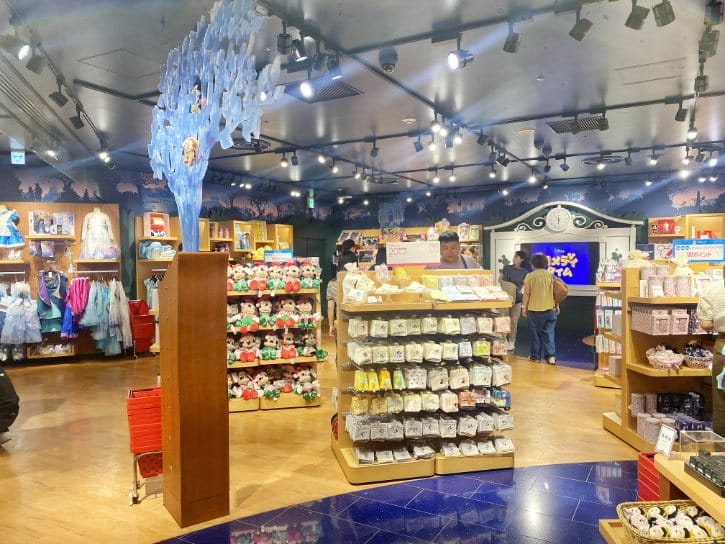
- Disney Store Kyoto Shijo Kawaramachi: Located near the intersection on Shijo Street. It offers official Disney items and collectibles.
- Nishiki Market: Famous food market known for fresh local foods, snacks, and traditional sweets. Great place for tasting and buying souvenirs.
- Teramachi & Shinkyogoku Shopping Arcades: Covered pedestrian streets with budget-friendly clothing, souvenirs, anime products, and casual dining spots. Ideal for inexpensive shopping.
- Don Quijote (Donki): A large discount store near Shijo Kawaramachi intersection selling snacks, cosmetics, electronics, and quirky souvenirs. It’s open until late.
- 100-Yen Shops: Visit Daiso and Can Do for cheap snacks, stationery, home goods, and small souvenirs.
- Drugstores: Popular stores like Matsumoto Kiyoshi (Matsukiyo), Sun Drug, Sugi Pharmacy, and Kokumin offer affordable cosmetics, skincare, medicine, and daily essentials.
e. How to Get to Shijo and Kawaramachi Streets from Nishiki Tenmangu Shrine
It’s a 2-minute walk from Nishiki Tenmangu Shrine to Shijo and Kawaramachi Streets.
7:00 PM: Dinner near Kawaramachi Street
a. Tendon Makino Kyoto Teramachi
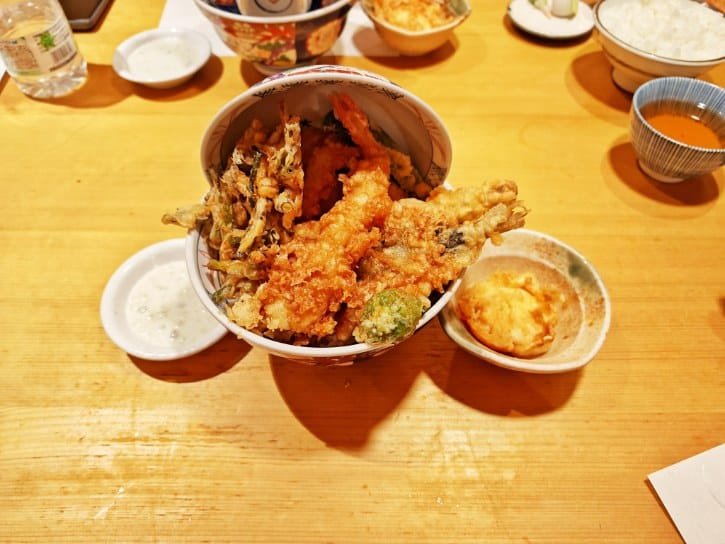
- What They Sell: They specialize in tempura rice bowls (tendon), serving crispy fried seafood and vegetables over rice.
- Must-Try Dish: Shoka Tendon, which includes shrimp, fish, squid and vegetables.
- Budget: About ¥1,500 to ¥2,500 per person.
b. Musashi Sushi
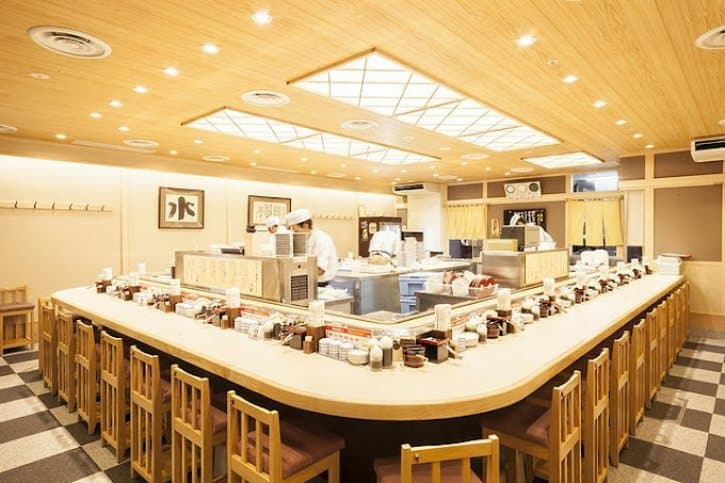
- What They Sell: A popular conveyor-belt sushi restaurant offering tasty and affordable sushi.
- Must-Try Dishes: Tuna (maguro), Salmon (sake), Kyoto-style Mackerel Sushi (battera), Grilled Corn Sushi, and Wasabi Eggplant Nigiri.
- Premium Options: For something special, try Sea Urchin (uni), Fatty Tuna (toro), Snow Crab, or Large Boiled Shrimp.
- Budget: Usually around ¥1,000 to ¥3,000 per person, depending on what you order.
Departing Kyoto for Kansai International Airport
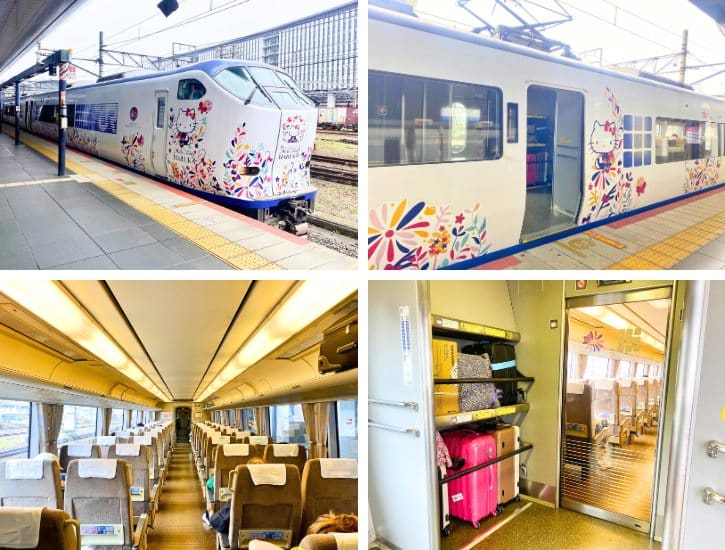
If you’re leaving Kyoto for Kansai International Airport on the evening of Day 7, you may skip some of the places I suggested for that day.
This way, you’ll have enough time to comfortably reach the airport.
Here’s how you can get from Kyoto Station to Kansai International Airport:
- At Kyoto Station, board the JR Haruka Express train heading directly to Kansai-Airport Station.
- The journey takes about 1 hour and 25 minutes, and the ticket costs ¥2,200.
- The first train leaves at 5:45 AM, and the last one departs at 8:30 PM.
Important Tip: If you’re departing from Kyoto the next morning, note that Kyoto Station is busiest between 7:00 AM and 9:00 AM. To avoid delays, consider leaving earlier.
Related Posts
Photo Credit:
Photos by PIXTA

